#slave/servant + master/owner dynamic...
Explore tagged Tumblr posts
Text
it is so unfair that jo.el is straight when he looks THAT pretty </3


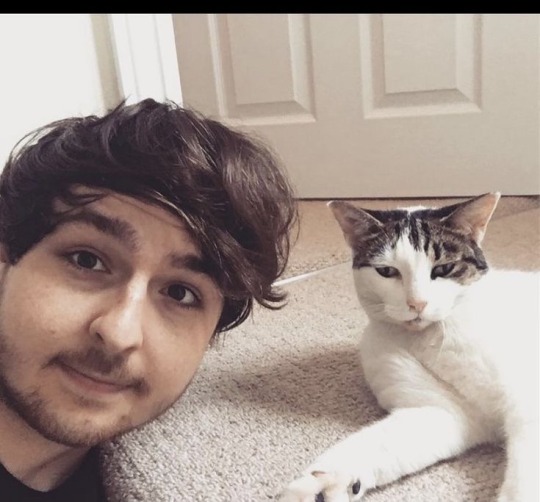






why can't he be hypnotised to be a servant for someone (me) already </3
#jo.el#not eepy#the fourth image especially...#. sweet dreams#come on guys </3 so unfair </3#slave/servant + master/owner dynamic...#he's my house husband. love him so much.
6 notes
·
View notes
Text
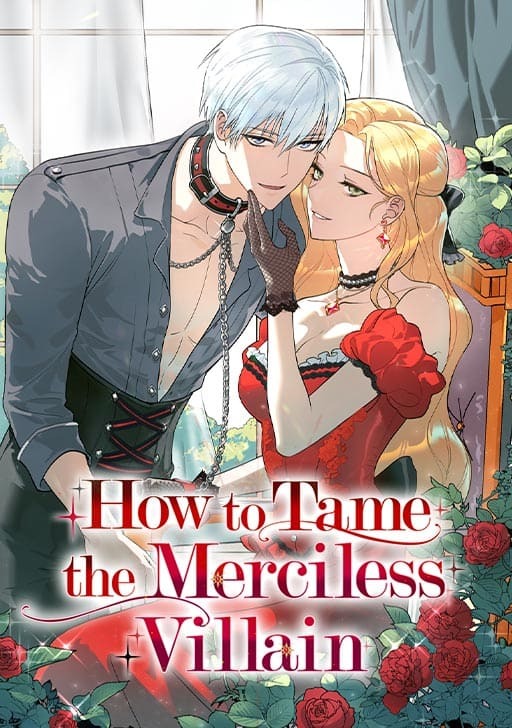


How to Train a Merciless Villain (Webcomic)
Created by: Peroche, MOoji, MUZO
Genre: Isekai/Romance
Yes, I know, I am an easy target for this one because boy do I love sub yanderes. There's not much out yet, but it does have the dynamic I generally crave which is a lot of the female lead takes care of the yandere, plus some sort of servant master relationship. As of current there are 11 chapters out.
The story starts out with Olivia facing her death as the villain Klein has gone on a rampage, killing all nobles in his path. When she is killed, Olivia wakes up in a carriage seemingly having had this nightmare for quite a while. She's isekaied into this story and is trying to find the main villain Klein. Klein was a slave in the story, bought from place to place, abused and sexually serving women until he finally snaps one day, revealing his immense magical power. After this, he basically starts hunting down and killing nobles. To prevent this from happening, Olivia has been traveling from slave auction to slave auction to buy him and prevent him from living a horrible life so that he won't kill her. She does eventually find him and buys him, bringing him into a nice room. When asking him to undress himself, Klein mistakes it for servicing her, which she shuts down immediately, stating that she only wanted to inspect the wound on his shoulder and that he should rest and live happily. Klein is touched by Olivia's kind words, especially after she buys him a ton of outfits and nice rings, which makes the other servants jealous. This leads to the other servants bullying him, locking him into storage, something that Klein accepts as this is how he's normally treated. During this time, Olivia breaks off her engagement with the crowned prince because of his betrayal during her death, something which seems to greatly irritate him. Olivia then ends up saving Klein and punishing the servant that was bullying him.
The rumor about Olivia buying a slave spreads extremely quickly, and Olivia decides to educate Klein on magic, making him into a patron. He seems to have innate talent for learning it, and Olivia invites Klein to a ball. There, the two of them meet Klein's previous owner, whom Klein seems to be terrified by. Olivia is able to protect him and also establish his status as no longer a slave and Klein starts to yearn more and more for Olivia. Olivia protects Klein once again when her uncle starts to abuse him. After some more studying, Olivia and Klein are invited by a famous painter to a party and although Klein feels a bit uncomfortable, he decides to join for Olivia's sake. He also sees a vision of the future where Olivia dies in his arms. After the nice party, Klein's vision comes true, with someone attacking the carriage they're in. This ends up killing Olivia, which unlocks Klein's magical powers as he tries to protect her. He swears that she will come back to him and brings her home. There he uses his magic to revive Olivia. While in this death state, she sees the pages of the story she's trapped in before finally waking up. We also get more context to Klein as a slave, seeing how he had to do anything to survive and that the reason why he wasn't killed as a child for being a magic useris because he was sold as a slave. Olivia was the only one who was really kind to her, as well as the fact that We also find out that the crowned prince was the one who tried to assassinate her.
As someone who really likes subby yanderes, this one is very nice to read. I am always a sucker for yanderes that are taken care of by their partner, and I love yanderes with love self esteem, so this webcomic was probably made for me. I will say that I'm not too fond of the plot point of Olivia trying to buy Klein for the sake of survival, since that gets dropped pretty much immediately after the first chapter or so. It would have been nice if she actually did help him more of the trauma of... well being a slave, since while she does show a great deal of kindness to him and even defends him amongst the other people who wronged him, she doesn't really address the main issue of slavery too much. I guess it's not like I should expect too much of it, but it can feel a bit strange since in theory, Klein would have basically just developed Stockholm syndrome for Olivia (though having a yandere with Stockholm syndrome is pretty interesting.) From what I understand from the novel, this is the kind of cycle that loops a lot in the story, where Olivia takes care of Klein and Klein ends up protecting her in times of need. This may or may not be to people's tastes as it seems that the entire story loops on this kind of premise. I also think it probably is kind of weird...? That while yes, Klein is finally treated well thanks to Olivia, it's kind of still a weird exploitative position since she's still his master...? I should probably stop complaining though, I don't get any subby yanderes ever, so this is nice for me.
What I do like is that Olivia is the one who is protecting Klein for most of the time, from abusive, showing the kind of caring nature she has but also is able to put her food down on things, such as breaking it off with the crowned prince almost immediately after finding Klein or standing up against her uncle, or even defending him during the ball. There is something nice about a main character who is able to protect their yandere in this way, since it makes it more meaningful when Klein is able to protect her back. It is kind of nice that they do incorporate the rumors that Olivia gets for basically going around to slave auctions and then immediately breaking it off with the prince, since, yeah, that's kind of a weird thing to do and does seem to strongly imply that Olivia is basically just using a slave for sex and romance rather than deal with the prince. I mean she isn't really doing any of that, but it's a more logical conclusion than just she's trying to find the person that is gonna kill her in the future and prevent them from doing that. It is kind of weird that nobody questions her just going around to slave auctions, choosing a white haired slave guy and then immediately upgrading him to her patron, because that is an extremely strange thing to do. I guess she's not concerned with any of the other slaves at all considering just how rich she is, which is kind of concerning. I do like the setup for the crowned prince being the one who sent the assassin to kill Olivia, which possibly could either lead to him being a yandere himself or causing various problems for Klein and Olivia in the future.
I really like Klein as a yandere since he is kind of the personality type I like which is somewhat equivalent of kicked puppy, but he isn't particularly interesting. Klein is definitely a tragic villain since we see that he was used all his life as a slave and when he finally hits his breaking point, he tries to kill those that oppressed him in the first place. He has a very terrible past, being sold when he was very young, watching the person who took care of him die because he wanted to protect him, being sold as a sex slave to multiple owners only to finally be sold to Olivia and live a much happier life. Personally though, I would have wished for Klein to have been at least a bit more skeptical about his suddenly good life, since I would have thought that he would have been at least a bit more concerned that his life went from really bad to really good in a snap instead of suddenly devoting himself to Olivia so easily. He seems to have accepted that it's normal to be abused by others, which is why he looks up to Olivia so fondly for his new life. We don't see too much of his yandere moments, in fact I think so far, it's mostly just displayed in the last couple of the currently available chapters, where he watches Olivia dies in his arms and then proceeds to almost kill the assassin, promising that the two will be together forever before reviving her and crying in his arms. My guess is that Klein will end up being rather overprotective of Olivia considering not only that Olivia is very kind to her (and that he likely has a crush on her) but also that if Olivia does end up dying, he will no longer have the nice life he has currently, and be forced back into being a slave. Considering he just unlocked his immensely strong magic, he probably won't ever go back to being a slave, but he does now have a big target on his back as the king was supposed to have killed all magic users to prevent a prophecy from happening. Now that both Olivia and Klein have targets on their backs, maybe they'll run away together to get them off of their back, but I don't think that's where the story is going. I still like Klein's devotion to Olivia though, the true kind of yandere thing I'm craving for.
Overall, while I think there are a lot of bumps and things, I still like it for what it is. Maybe just don't think too hard like I did or it might ruin your enjoyment a little. Still, I'm always an advocate for more sub yanderes, so if you are looking for them like I am, this one is a good story to read.
122 notes
·
View notes
Text
For when you flower I
Masterlist (coming soon)


Pairing: Emperor Caracalla x Greek!woman/reader x Emperor Geta
Warnings: 18+, minors dni, mentions of violence, blood, death, and slavery, hints of PTSD/bad mental health - there will be an imbalance between the owned and the owner (sexism, oppression, etc.), toxic relationship at some point
Tags: Enemies to lovers (?), triangle drama/love (but no incest, I swear), unhealthy/toxic dynamics, slave x masters basically (for now), no use of y/n, 1st person narrative
Summary: A greek woman has been stolen from her lands, Hellenes, and in the midst of questioning her faith and destiny, she ends up before the feet of the emperors.
( World building :)) ) Word count: 1.9K

A/N: In this story there will appear a few words that's either ancient greek or latin (I study the languages, I know, super cool :ppp) - so I will make sure to add a little note once in a while when a new word pops up that I feel like is important for you to know. Though bare with me as I will not include some of the words... because not even the main character knows the meaning of the words sometimes.
In the worst cases: trust your gut. Believe me, when I say english isn't that far from latin.
This is the first story on my page, so please, if you like this chapter, show support by liking, reblogging and commenting. It'll really motivate me!! Thank you in advance <333 And now, I present chapter 1 of the story "For when you flower."
Dictionary for this chapter:
Hellenes = the actual name of ancient greece Aphrike = the ancient greek name for Afrika Nemesis = both a god of justice, but mostly a term for revenge when greek had committed hybris - broken the rules given by the gods, which were made to keep the world in order

I was taken from my home.
Not too long ago I was in Hellenes, the land of the gods. I was surrounded by my people, by our culture. A people who remained in pain of the filth stowed upon them day after day. A culture robbed of its riches. We were oppressed in our own home – but it was still ours. Ours to appreciate in the shadows, hidden from those not worthy of the glory. It was like one people of the other claimed our land as theirs. There was no peace other than in the dark hidden from the Persians and from the Romans.
It was in the shadows we allowed ourselves to continue our faith, to pray for mercy from the almighty gods. There was no justice outside in the light. Oh, how they dragged our names in the dirt.
It was in the shadows where the statues of the great remained, statues of the house gods to whom I owed my life. There was so much they could deprive us from but not hope. Not then in our land, Hellenes.
I remember the day I received my prophecy. It did not speak of the agony I now find myself drowning in, no, it spoke of a resurrection of the people, of the belief.
I was to be an oracle. A hope. It had said: “A holy war in sight, only you can conquer with might. What’s been small and fragile in the past, will then flower from your hands.”
I was never the person to question the Gods intention – on the contrary I was honored to be given such kind words from those who we were taught to fear. I was looking forward to the day the prophecy would be fulfilled, the day were I was to serve the God of all good, sun and light, truth and prophecy, Apollo.
His name has lost all worth for I was brought out of the dark – not by will. And I cried. I cried a river but none of my prayers were heard.
It all changed the day the Romans came back.
I knew of the cruel nature of the Romans – of how they kidnapped and abused our land, but I was yet still too naive to think that they never would dare to touch the sacred, the ever so respected priests and priestess of the divine. They crushed the blest spirit, the day where light was shone on the serene shadows.
In truth I was only starting to understand the practices that were expected of me to perform. Rituals. I was yet to be the oracle, humble servant of Apollo. However, I still had a title to which previous Roman soldiers had respected and truly endeared.
I still remember the roman soldier that had asked for my guidance. Oh, how his eyes lit up as truth and prosperity embraced his whole. I showed him the way into the arms of Hera, Mother of Gods. Maybe he was lying – another mockery.
Hera, Apollo, where are you?
The event of my abduction is merely a night terror in my head by now, consuming my every thought; Every nerve jolting at the irreversible pain that had been caused by the filthy, the Romans. Every second has been a battle to actively try to suppress the memory of that day, that night, that month, that year. The only memory left by now was the change of weather from Hellenes to Aphrike to Rome. The grief, the wicked and the filth. And that one man.
Hellenes is now barely a wrinkle in the dent of my cheek. An echo in the weariest of nights where sleep caresses me at last with promises of new hope, a new life. Something no God seemed to care to give to us anymore.
The Gods barely matter. That’s the truth. Today, as I sit with my hands tied, I believe that they were erased together with the rest of torment. Burnt, broken and beaten. I still pray, yes, but no longer with fear as they intended, no, it was disbelief and grief – and that was no righteous way of praying to the Gods I once knew, but it doesn’t matter. What horrid thing had I done that the Gods placed me in the hands of predators to obey? A feel of surrender not only towards Nemesis but also those I now call my masters, domini.
What a horrid word.
Today I sit behind bars with hardly anything to cover up the shame of my position. I have spent maybe a hundred days in this forsaken land, learning their dirty tongue in hopes of finding my eventual master. One, who I hope would have mercy. And perhaps today was the day the Gods finally hear my prayer, or maybe I’m still naive to hope.
I’m being transferred to a place, I have yet to understand the meaning of: Palatium. The name itself placed a heavy weight on my heart like a blanket of steel. I will not give up.
The slave trader waved our carriage away. By my side are other women as well as men, men of honor. All sit mute as If our tongues had been cut off, deaf as if our ears were burnt. In silence we agree that everything has seemed a blur since that day the free became the forced.
Around us men and women dressed in silk and tunics of pride bore at the sight of us. Those who would show interest were collectors which could be seen clear as day by their make-believe costumes of the people of Hellenes. Us. They want us, not because of our personal value, the virtue which was supposedly given to us by the supposedly righteously gods, but because of our skin, our blood. They had that in common with the men, scouting gladiators in between our honest men, the heroes of Hellenes.
The injustice floods my already burning chest. My heart is beating but for what? Beating against the steel and iron like the drums of war. I bite my cheek as I feel the phantom sensation of tears flocking my arid eyes. Damn you, Gods. Despite the growing distrust I urge myself to mummer a prayer in our mother tongue with eyes squinted close: “I ask for your justice, righteous Dike, for your mercy on my soul and for whatever deed lead me here, Nemesis. Ares, I summon your war to these wasteful souls that do not honor your name. Oh, Zeus-“
“Quiet down.” The woman to the right mummer. “The Gods intended this. We will meet the ends of our suffering soon enough.” I could feel how I was quick to anger over how she sounded so reassuring – but mostly also how she was right. Peeking a look at her I meet not a woman, but the ghost of life displayed and laying across her pale face. She’s an old woman, probably not intended to see the light of day. Other than her wrinkles, there is no identity to be seen or studied. Her appearance no longer mirrors whatever woman she had been as her clothes are merely a used bag, her hair thin and shed, dead on her shoulder. She will likely be bought for nothing but labor. A prime example of a worthless slave in the eyes of the filthy.
My anger now replaced by pity. Sadness.
“Apologies.” I slightly nod and purse my lips. I feel my eye twitch. I ponder of her name, but I choke on the words. Embarrassed, I lower my head.
The next thing I hear is a rustle. Perhaps she had read my thoughts, maybe not. A short moment of quiet follows as her hand caresses mine. Comforting. Motherly.
Maybe Hera is here after all.
Suddenly the world begins the spin as the carriage suddenly stops and puncturing whatever hope, the woman had planted and sown. Dizziness takes a hold of my consciousness. The world seems to blur once more. I feel my body become weak and heavy. Her hand on my cheek. Her shoulder next. She saves me from the floor. She holds up me upright.
Our movements become flashes. The world so dark. The next thing I know, I’m on marble floor.
The air here seems heavy and loaded with scents of war. It strikes and pokes my insides like spikes. Carefully I tip my head up to look around at the surroundings – only to meet the toes and the feet of a man, sandals of a noble.
“You brought a weakling into the house of gods?” The sandals huffed. “Surely, you must be pulling some kind of cruel joke.”
It’s like his voice barely made it through his gritted teeth but I cannot see. The muscles in my neck ache. But I feel her hand. The woman is still holding me. It calms my nerves, and I seem to forget the pain.
“And an old woman.” I watch the right foot tap and as it jingles with all its riches. “I cannot believe this… this… insult! This is an insult – towards the gods, let alone the emperors! What will they think?”
“I reassure you; she was fine a moment ago! One of our finest samples!” I recognize this voice to be the dealer, the man who bought me off the coast of Aphrike.
“How am I supposed to make any of these women presentable?” The sandals raised his voice slightly but were quickly to draw a breath. “Out.”
It sounds as if the words were venom, shooting from the teeth of a python. No doubt that this man has power.
“But-“
“No! I said out. Before the emperors see these-“
“See what?”
The atmosphere changes.
A new pair of sandals makes their way across the floor, scraping whatever dirt there is up. A pair of feet who seem too weak to bear the heavy burden of its body or its mind, erratic in its every move. And yet so weary and tired.
And then there were quiet.
It feels as if a minute passes by before any other word is being spilt. The burdened speaks again, marginally more distressed: “Speak up for I wish not to be left out.” The voice takes on a child-like attitude, one which knows no laughter, only squabble and snappiness of the upmost impatient kind. A part of me wishes to look and console this unfortunate soul.
The fancy sandals jerk. “Sorry, my emperor, I was just telling this joke of a seller off because of this abomination of a delivery. I assure you; I am picking only the upmost desirable for you. Ones in the best of health.”
A wish now broken.
“And what do you know about health?!” The voice snaps as if the sandals words truly had offended its entire bloodline – its apparent noble bloodline. Filth.
“That was not-“
“OUT!” It screeched. The sound of a blade rings in the room, making me lower my head by instinct. Blinking, I feel a pain ache in my heart flashing, not of physical pain but of pure agony within my soul. Memories, nightmares flash before me. The thick scent becomes recognizable. My dearest friend as of the last year. The smell of iron. Of blood. The only proof of life and of worth.
Once more it blurs. My soul cannot take this torture any further.
“Caracalla! Calm down!” Is the second to last thing I hear.
“Geta! He is-“ Is the last thing I hear.
I remember them faintly. Their names. The fear that infiltrated my home, my people.
The twin emperors; Geta and Caracalla.
Oh, how I resent them

Next chapter (coming soon???)
#emperor geta#emperor caracalla#gladiator ii#gladiator 2#fanfiction#gladiator fanfiction#enemies to lovers#joseph quinn#fred hechinger#For when you flower#emperor geta x reader#emperor caracalla x reader
19 notes
·
View notes
Text
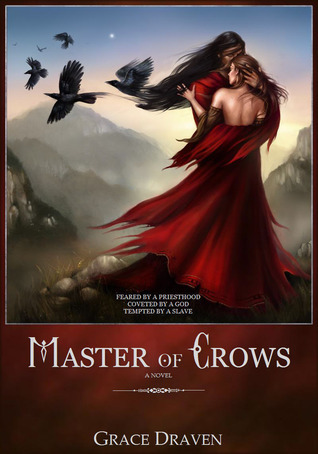
Master of Crows. By Grace Draven. Self Published (?), 2009.
Rating: 2/5 stars
Genre: fantasy romance
Part of a Series? Yes, Master of Crows #1
Summary: What would you do to win your freedom? This is the question that sets bondwoman, Martise of Asher, on a dangerous path. In exchange for her freedom, she bargains with her masters, the mage-priests of Conclave, to spy on the renegade sorcerer, Silhara of Neith. The priests want Martise to expose the sorcerer's treachery and turn him over to Conclave justice. A risky endeavor, but one she accepts without hesitation--until she falls in love with her intended target. Silhara of Neith, Master of Crows, is a desperate man. The god called Corruption invades his mind, seducing him with promises of limitless power if he will help it gain dominion over the world. Silhara struggles against Corruption's influence and searches for ways to destroy the god. When Conclave sends Martise as an apprentice to help him, he knows she's a spy. Now he fights a war on two fronts -against the god who would possess him and the apprentice who would betray him. Mage and spy search together for a ritual that will annihilate Corruption, but in doing so, they discover secrets about each other that may damn them both. Silhara must decide if his fate, and the fate of nations, is worth the soul of the woman he has come to love, and Martise must choose continued enslavement or freedom at the cost of a man's life. And love.
***Full review under the cut.***
Content Warnings: sexual content, blood, magical violence
Overview: After being a little lukewarm on Radiance, I decided to give Grace Draven one more try, mostly because her books seem to be popular on tumblr. I picked up Master of Crows on a whim, and though I think it has more plot than Radiance, the main characters were really not to my taste. For me, Martise was too passive and Silhara was too much of a jerk to be likeable, and the massive power imbalance between the two meant that I didn’t really root for their relationship to succeed. Thus, this book only gets 2 stars from me.
Writing: Draven’s prose is fairly straight-forward. It’s easy to get through and it flows well, giving the reader just enough to know what’s going on. I don’t really have any criticisms for its simplicity because Draven is writing within romance, and the point isn’t to be poetic. Rather, it gets the job done, and I think most readers will appreciate that.
Where I do think I can criticize this book is in the repetition of phrases. More than twice, I saw the term “half mast” used to convey when a character’s eyes were half open, and I think I saw “tattoo” used multiple times to describe a rapid rhythm or tapping. It’s not the biggest deal, but I was definitely pulled out of the story when I noticed these things.
I also think I can criticize Draven for telling us some things that should have been shown. We’re told, for instance, that Silhara isn’t a noble man, that he’s selfish and ambitious, etc. but we’re never really shown scenes of him acting out of ambition or being actually tempted to give in to Corruption’s influence. I would have liked to see Silhara be put in positions where he is making choices or doing things that make the reader think he was susceptible to Corruptions influence. Maybe we see him researching spells for making himself more powerful. Maybe something happens on page with Conclave that is so bad, he starts seriously considering Corruption’s offer to give him revenge. It could be argued that we do get some of that, but it felt like everything was told to us, or happened in the past, and we were expected to absorb it.
Plot: Most of the non-romance plot of this book revolves around Silhara trying to figure out how to destroy the god Corruption while Martise acts as a spy, trying to get some dirt on him so the Conclave (a collection of priests/mages) will have an excuse to kill him. To be honest, I thought the initial premise was a good one; I liked the idea of conflicting loyalties and the eventual shift from enemies (of a sort) to lovers.
However, I do not think this plot was handled well, mainly because Corruption seemed to be a background threat. Multiple times throughout the book, we see Silhara be more or less tormented by the god, whether through dreams that keep him up at night, through disrupting Silhara’s magic abilities, through manifestations, and through temporary possession. While scary, I don’t think these scenes had much lasting impact, which didn’t make Corruption feel like a real threat. If Silhara is being kept awake at night, for example, I want to see scenes where his sleep deprivation gets him in trouble. If his magic is out of control, I want to see scenes where he has to decide whether he wants to risk using it or if he should go through his life without his powers. Something other than Corruption just being a lurking boogeyman that occasionally pops up and becomes a nuisance rather than a real, omnipresent force.
I also think Martise’s plot was a bit weak, mainly because we’re never really shown her having conflicting feelings or arguing with herself about whether or not to give Silhara to the Conclave. Martise is a slave, and her master promises to free her if she can get dirt on Silhara. While fine, the desire for freedom never seemed like a driving force for Martise; we never see her digging through Silhara’s study for potential dirt, of trying to eavesdrop or do other things that would show her actively trying to achieve her goal. Instead, Martise is rather passive, waiting for information to come to her, and she never really wrestles with her life as a slave, not the decision of whether or not to report Silhara once she falls in love with him. I would have liked to see more angst or at least more of an evolution where it felt like Martise had an arc independent of her service or usefulness to Silhara.
Characters: Martise, our heroine, is rather passive and seems to exist mainly to be used. I really didn’t like that she seemed to have no ambition or agency; she mostly waited for things to happen to her, and only shows agency towards the end, when the big showdown happens. Even her “gift” - the magic ability which lays dormant in her until Silhara awakens it - seems to be built around her being a tool to be used, and I was extremely disappointed that her arc didn’t seem to be about empowering her as a woman or as an ex-slave.
Silhara, our hero, is the type of love interest I absolutely hate. He’s extremely powerful, but is a complete jerk to the heroine and commits random violence towards other people out of jealousy. While we’re told over and over again that Martise loves him because he’s a good person at heart, I really didn’t see it. He not only beats up someone who speaks poorly of Martise, but he also seems comfortable ordering her around and treating her as a servant until the very end. The only redeeming qualities he had seemed to be that he doesn’t like people treating women poorly (which, ok, I guess) and he’s kind to his servant, Gurn. Other than that, he’s not an alluring figure.
Side characters were fun, if under utilized. Gurn is Silhara’s mute servant who uses a kind of sign language to communicate. I really liked this character because it inserts some disability representation, and I liked his relationship with Martise. The two seemed to bond over their shared status as servants, and I honestly wish there had been more of an arc or exploration about class with these two. Other characters served their purposes. Cumbria, Martise’s owner, is largely absent, but manages to look bad in every way. He’s not a super compelling antagonist just because he’s not on the page too often, but when he is, I think Draven did a good job not making him over-the-top evil. He’s mostly just greedy and petty, and I wish he had been used more deliberately in conjunction with Silhara’s exile as a commentary on corruption within religious orders. Corruption, the god, is a different story. As I explained in the plot section above, Corruption isn’t much more than a boogeyman, and I got really tired of him really fast.
I’m not sure how to feel, however, about the Kurman people in this book. The Kurmans are a nation/ethnic group/tribe/society with some rather odd gender dynamics. Women can apparently own property and vote, and they are supposedly respected, but they are kept separate from men much of the time, wait on men at feasts, can’t meet men’s eyes unless they want to communicate sexual availability, and so on. It was rather bizarre to me, and I seemed to be getting conflicting ideas about whether or not this society was feminist or not. I also wasn’t sure if they were supposed to be modeled on any real-life ethnic groups or societies; they are described as wearing pointy shoes, having swarthy/dark skin, having multiple wives, etc. so I got the impression that they might have been like Arabs, Mongols, or Ethiopians (due to the food they eat, etc), but if so, I didn’t quite like how Silhara refers to them as “barbarian,” even if it was in jest.
Romance: I couldn’t get on board with this romance. At all. Martise was already too subservient as a character, and while I get that some of this could be a survival technique, it didn’t make sense that Silhara would fall for her based on the ways in which she surprised or challenged him. Because she barely did. She never called Silhara out in any meaningful way and seemed to go along with whatever he wanted until the end.
Most of my discomfort, however, comes from two main issues: 1.) Silhara never seems to put Martise’s well-being first, and 2.) there is a huge power imbalance between the two that isn’t corrected until the very end, and Silhara never seems to be interested in leveling the playing field. First, Martise’s well-being: Silhara constantly offered comments that seemed to tear Martise down or, at the very least, be a back-handed compliment. He never seems to want to find ways of making her happy, and he centers his own desire and well-being even after big things happen. For instance, in a scene where Silhara is temporarily possessed by Corruption, he hurts Martise so badly that she cannot speak (as in, he chokes her almost to blackout). When he is freed from possession, he never seems to care about what he did to Martise or how she might be in pain. Instead, the first thing he does is order Martise to get away from him, then he orders Gurn to look after Martise to make sure she’s ok. All the while, he focuses on his own pain and jokes about his balls (which Martise kicked in order to free herself from his grasp). I was flabbergasted - why wouldn’t you want to make sure for yourself your lover is ok after something like that?
Second, the power imbalance. Even though Silhara doesn’t know Martise is a slave for the majority of the book, he does take her into his household as a servant, and has no qualms about ordering her about or taking advantage of her gentle nature. You’d think that if someone fell in love with a servant, much of the romance would be about overcoming class barriers or finding some way to put the two characters on equal footing. Sometimes, this is done by the lower class person having a sharper wit or calling out the upper class person on things that make them change for the better. Martise and Silhara never seem to have that arc. Martise calls Silhara “Master” throughout the whole book, and Silhara didn’t seem uncomfortable with it except when they were having sex. He never stops presuming to give Martise orders and expecting she obey them, not even at the very end when the question of her freedom gets resolved. And there are books out there where this class barrier is done well (Jane Eyre comes to mind), so I think Draven could have put more work into exploring the dynamics and how Martise is a match for Silhara, even given her status and lack of magic (at least, for a while).
TL;DR: Master of Crows has a good premise, but ultimately suffers from unlikeable or passive protagonists, a weak plot, and a romance with uneven power dynamics.
4 notes
·
View notes
Text
This Week’s Episode
I just watched it, and boy do I have opinions.
They’ll be published in full later because right now I’m a little too agitated at yet another forced “Naruto definitely changed the Hyuga!” that SP has slid into Boruto to save a failed arc. The Hyuga have poor writing, and if anything I’m absolutely furious at the logical fallacy of ‘willing’ sacrifice they keep championing as a noble cause.
To summarize my thoughts for right now:
The Hyuga had three original issues, as brought up by Neji in the original Chunin Exams Arc.
I. The Caged Bird Seal (Subjugation)
No, Naruto did not keep his promise. The Hyuga have no evidence of being ‘changed’ aside from Hiashi’s ‘soft’ attitude. The fate of the seal (the ORIGINAL ISSUE) is still indeterminate at best. There have been no comments made about the Caged Bird Seal in Boruto, even in conversations between adults. This is not evidence that the seal is retired.
And on top of that, I’m not convinced that it may be gone for this very reason:
During the war arc, Neji and the other branch members still had their seals, even though Hiashi made a throwaway comment that the clan was “unified.” Thus, even if we buy into the narrative that the clan was ‘unified’ by the time of the Fourth war, the removal and retiring of the seal was not necessary for the arc to be considered ‘closed.’
Edit: I'm aware that Neji stated that the seal is only removed upon death. I'm currently researching further into the matter, but I think it's extremely unlikely that the seal is completely irrevocable given that Sasuke/Itachi/Anko were able to disable and/or remove their own seals from Orochimaru, which were the same level (A-Class) of seal.
Uh, pardon me?
The issue with the seal is its very existence. To remedy the original issue, the story must either create a seal without a ‘punish’ function, or remove all of the seals. Otherwise, the conflict is not resolved.
The Caged Bird seal can, at any time, be used to quell dissent in the household so long as it exists. The seal was also portrayed as evil and horrifying in the original series by all who come to know of it. Why has this not been addressed?
II. The Structure of the Household (Power Dynamics)
The Hyuga STILL HAVE BRANCH AND MAIN HOUSES. Note that other major clans (Such as the Akimichi, the Aburame, the Uchiha, the Nara, etc.) do not adhere to this structure in the same way that the Hyuga do. This is because the traditional Japanese family head/branch structure always made provisions for candidates outside the direct lineage to succeed power if deemed necessary, usually by proving themselves to the head.
This happened between Hanabi/Hinata, but was never an option for branch family members.
Also, Hanabi’s skill did not match Neji’s in any capacity. In a real-life historical scenario, one of two things would have occurred:
Neji would have been suggested to compete for headship due to his skill and family-wide recognition of his abilities, especially because he also had the clan head (Hiashi’s) recognition. Neji would have faced either Hanabi or Hinata. This may or may not have caused issue within the family, but would have been even more unlikely if the (more likely) second situation happened, which is:
In a historical scenario, particularly because Neji was in extremely close relation to Hiashi already AND his father had died, Neji would have very likely been adopted by Hiashi into the Main family and been treated as his real son. This would only be further supported by the fact that Hiashi felt so strongly about his responsibility to his brother, making the care for his brother’s offspring an obvious duty.
This did not happen because the Hyuga household is a twist on the actual version of the feudal family structure. Branch houses were never subjugated to the main family, they swore fealty willingly for protection and privileges (and did not have to be related by blood!)
The original main/branch structure is respected due to the innate moral/cultural beliefs in honor, sworn fealty, and duty. The presence of the Caged Bird Seal is the introduction of subjugation by force, threatened torture, and fear and is a subversion of this structure.
Also, please stop comparing the Hyuga Branch members to Western (particularly American) slavery. I cringe so hard every time I see a rant about Hinata/Hiashi being Neji’s “slave owner.” This completely disregards the culture from which the story comes from. While branch members in the Hyuga are subjugated, they are akin to ‘expendable vassals,’ ‘servants,’ and ‘bodyguards.’ Slaves would not be allowed to operate as active shinobi (soldiers) and to work for the greater government. Hiashi is their “lord,’ not their ‘master.’
III. The Fate of the Branch...To die for the Main (Authority)
This part of the storyline officially closed after Neji died because it was an unfulfilled arc.
Neji wanted freedom from his preordained orders to die for the main branch at command. Hizashi wanted the same.
The logical issue with their “freedom” is as follows:
If someone puts a gun to your head and tells you to flip a switch that will electrocute you to death, you have two options:
1. Flip the switch (death)
2. Refuse, be shot (death)
In the strictest sense, you might be able to convince yourself that you may willingly choose to die by your own hand and flip the switch. But, had there been no outside controlling force (the gun) you would likely have never chosen to willingly flip the switch. Any person could just as willingly say that they “choose to die by the gun” instead and there would no change in the moral outcome of this scenario.
This is because there is no choice (freedom) to change the outcome of the situation. This is what Neji meant by fate/predestination in the original series, and why the only shared fate is ‘death.’
The Hyuga Branch wanted the freedom from being forced to die upon command.
“But Neji died to save Hinata and Naruto! He wasn’t forced!” -- Yes. The issue with Neji is that Kishi deliberately parallels the narrative of his father and had even placed Neji’s character in that situation to begin with.
The Naruto series keeps falsely trying to shove this twisted version of ‘freedom’ as though it were a noble choice. Both Hiashi and Neji did not have the freedom to choose to ‘live’ and were thus always lacking the power to change the outcome.
Neji’s death was a deliberate parallel of his father and meant to once again uphold the same philosophical idea that Kishi and SP keep hammering: That the scenario I outlined above is true ‘freedom.’ No, it’s a coercive choice.
I can’t respect the writing for supporting a blatant logical fallacy, which is why the Hyuga storyline is a failed piece of writing. It would be better if SP just dropped it and buried it like they did in Shippuden, because this is a sinking ship.
#Yes I deliberately shortened the real philosophical debate about coercion and freedom for the purposes of this post#I'm so furious#I hardly get this upset over shows and stories#but this is blatantly bad writing#and a false message for an audience#Neji#neji hyuga#boruto#studio pierrot#hizashi#hiashi#hizashi hyuga#hiashi hyuga#hyuga#hyuga clan#anti naruto ending#naruto discourse#Open for Discussion#Feel free to drop your opinions in my inbox because the askbox has a character limit#theshinobiway#the shinobi way#pumpkintalks#pumpkin talks
163 notes
·
View notes
Text
Seeking NSFW long-term RP Partner [m/f, f/f, third person, literate].
Hello, I am reposting this ad because the partners who I had chosen were no longer interested. That being said, if you have contacted me before and I haven’t replied to you, it’s because I had already found my partners. People seem to want to know even if I am full, though, so this time I will try harder and message everyone back to inform them that I have found enough partners if it comes to it.
Having said that, please don’t be afraid to remessage me again. I have added a few more plots in here, this time with a more detailed summary and not simply a pairing. Have a look and see if you like anything!
Disclaimer: I am above 18 and all characters in the RP will be so as well.
What are you looking for exactly?
Someone who is okay with the main focus of the roleplay being of an erotic/smut kind. That being said, I’d like it if we could include some sort of plot and story as we go along so it doesn’t become too repetitive and stale. (Pairings listed below)
Specifically, I’m looking for someone who would like to explore a dom/sub dynamic, which may include a master/slave relationship or anything of the sort. So you see, I’m not looking for the typical vanilla pairing. I’m seeking something a little more dynamic, complex and adventurous.
Someone who is okay with playing a dom against my female sub. I’m into both m/f and f/f, however take note that the kink list and plots below are written for m/f relationships simply because that is the pairing I get asked to do most frequently. They can all be changed to fit a f/f relationship though.
Someone who is okay with OOC chatting. I’d like to create a bond with someone, and I don’t want our only interactions to be only when we’ve posted. It makes me feel less connected to the RP and I’m more likely to get detached over time. We can talk about our everyday lives, our characters, possible future plots, share some music, etc!
Someone who actually gets invested in his own character and gives him life: a (realistic) faceclaim, some backstory, hobbies, dislikes, etc.
What are you expecting from your partner?
I am expecting you to be able to write several paragraphs. Sometimes my posts tend to go up even to 1000 words, so be prepared for that. I’m not saying you have to write 1000 words per post, but writing more than one paragraph would be ideal.
Third person only.
I am expecting you to be upfront about what your likes, preferences, and what you’d like to get out of from this RP. Saying ‘whatever works’ for every question I ask makes people seem like are an extremely passive person, which is not what I’m looking for. I’m looking for someone passionate about writing and who wants to collaborate with me by making his own contribution and being honest.
I’d like a partner who is active, and I want to stress this because I don’t want people messaging me when they cannot post at least once every day or two. More is appreciated, but I get life can get busy with work and all. That being said, I don’t want to wait for five days or more for a reply. It’s not that I’m not tolerant, but I will quickly grow uninterested in a RP (especially an erp) when we don’t have a constant flow of replies.
Characters that I love playing against: older men (40s-50s), beards are a big bonus, big rough guys who deep down have a gentle heart, characters with tragic pasts and seeing their life still being affected by it, bad habits/addictions, unhealthy relationships and behaviour, angst and anger issues, etc.
What should your partner expect from you?
Most of my work done is through my laptop, thus I am fairly active and am always up for chatting. Apart from that, you should expect 1 - 3 posts everyday from me.
Despite this being a NSFW rp, my characters are not going to have the physical appearance of a porn star or anything like that (i.e., gigantic boobs, perfectly curvy body, huge ass, etc). They are going to be realistic, is what I’m trying to say.
I put a lot of effort when creating a new character, including finding them a faceclaim. I use realistic faceclaims, sometimes realistic dawings, as long as they are not anime/cartoon.
My characters are: Usually young (18-25), initially soft and timid but will definitely get back at you if you piss them off, start off as shy and inexperienced but eventually grow confident, will tease a lot (public or not), bratty, can be impulsive and can get themselves into trouble, need attention, etc.
What are some possible pairings we could use?
Italic text is the role I’d prefer to play. You are welcome to mix and match these pairings, as well as bring forward suggestions if none of them interest you.
Rich businessman/Bought slave
Your character grew up in a rich household. After both of his parents died (or moved someplace else), he took charge of the house and was given authority over one or several of his father’s businesses in order to follow in his footsteps. His large house started to grow lonely, save for the servants and maids that took care of everything, but he needed something more. Somehow he finds out about women of all ages being auctioned as slaves in an underground place, and after some hesitance, he decides to go. Surely enough, his attention gets caught by a fairly young one, the main attraction of the night indeed, and he instantly knew that he had to get her.
New prostitute/Regular client OR New prostitute/boss
My character is a newly recruited prostitute in one of the city’s most famous brothels, who joined as a last resort kind of thing. Could be because of family issues, or she couldn’t keep up with paying for her bills, perhaps she was involved with some certain things that made her get kicked out by the landlord of the place she had been staying at. Either way, she is only there because her situation got desperate. Upon arrival she is given a room to stay at, some clothes, explained the rules, and a bit of training to prepare her for that same night. Enter your character, who has been a regular at this place and will be her first client. He pays for her services, but once they go to a private place together, he can easily tell that this is her first time doing this sort of thing. How this continues is up to you and pretty open, but the main idea is that they end up growing fond of each other and wanting to meet again.
Alternatively, we could do a similar plot, but instead it would be with her boss and the owner of the brothel.
Your idea.
I’m open to hearing whatever ideas or plots you’d like us to play. Perhaps you have been craving a specific pairing, or you have a plot that you started with someone else but got ditched. I’m here to listen!
Other pairings we could try:
Stalker/Obsession
Teacher/Student
Doctor or Psychiatrist/Patient
Kidnapper/Kidnapped
Greek mythology pairing (I’m not too familiar with these except for Persephone/Hades, so feel free to bring your own if you’re interested in this)
*I’m also into supernatural creatures (werewolves, vampires, witches, etc) and it’s definitely something we could incorporate into our plots.
What are you into when it comes to NSFW, and likewise what are your limits?
My kinks include: Dd/lg, orgasm control, light bondage, collars and leashes, oral, gagging, roughness, spanking, bdsm, breath control/choking, light petplay, clothed sex, outdoor/semi public spots, dub con, humiliation, dirty talk, name calling, body worship, masturbation, pain play, being marked (bruises, hickeys, etc), handcuffs, controlling and possessive behaviour, and probably some more that I can’t think of on the spot.
My limits are: Scat, vore, watersports, feet, unrealistic body proportions/sizes, excessive cum, basically anything unrealistic. If you’re unsure about something, ask.
I’m interested, where can we contact you?
Happy to hear that! Shoot me an email at [email protected], and we can see where this goes. If we’re compatible and decide to RP together, I will give you my discord.
Make sure that upon contacting me you tell me a little bit about yourself, some suggestions/ideas, what you’re looking for, etc.
2 notes
·
View notes
Note
Have you played all of Nadia's endings? I've played Nadia's upright ending (and I loved it) I'm considering if I should play her downright too? Is it good? I've heard it contains quite some triggers, anything you know about that?
Yes, I have played all of the endings. Nadia’s reversed is… Intense to say the least. I liked it, thought it was very interesting. But I can definitely see how some things may be unsettling or triggering. I don’t want to spoil it for you, but you can expect some acts of cruelty, character death, mild gore, and relationship dynamic that could be seen as unhealthy and triggering for people who have been in mentally abusive relationships. If you want to know more, I will elaborate under the cut, but be warned - it will contain some serious spoilers.
Cruelty - Nadia in the reversed ending is quite cruel and she shows that she doesn’t trust anyone and holds little to no respect or positive feelings towards her familyDeath - Lucio dies in Nadia’s reversed ending, like in other reversed endings. What’s really unsettling about this one is that he’s actually killed by Nadia.Betraying MC - in the first book of the reversed ending, you are led to believe that Nadia will trade the MC for a deal with the Devil. I know it was quite shocking to many people. Although it is a trick, the feeling of being sold out can be strongAnother death + gore - The Devil Arcana is killed by Nadia in a quite gruesome way - by ripping his heart out with her bare hands. Then, she “absorbs” Devil’s power and takes his place as an Arcana by making the MC push the heart into Nadia’s chest.Master/slave relationship dynamic - Nadia is a dom in the upright ending too, but you can feel that she actually respects MC. In the reversed ending you feel that the MC is sort of a “mindless servant” to Nadia and that she takes advantage of MC’s powers to obtain her goals. While it is consensual, it could be triggering for people who were in abusive relationships. Owner/pet relationship dynamic - Nadia also treats MC in a way that suggests seeing MC as her pet. The perfect example of that is that she gifts MC a collar. Devious intentions - it is hinted, that she cares very little about those who were left in the “real world” (Asra, Julian, etc) and that she has some sort of a devious plan that would let her come to the real world and shape it to her liking. All pretty ominous.
All things considered, I still really liked the ending. It had good writing and was a perfect display of how feeding Nadia’s paranoia about her family and the feeling that she can only trust herself to get things done can radicalize a person and twist the way they see the world. Play at your own risk
#The Arcana Game#upright / reversed#Nadia Satrinava#Nadia reversed#reversed ending#Arcana reversed ending#Nadia reversed ending#Nadia route#upright/reversed
41 notes
·
View notes
Text
Single and Loving It? Wallada bt. al-Mustakfi, Lizzo, and the Breakup Blast
The first line of Lizzo’s chart-topping ode to making better choices, “Truth Hurts,” can be taken a few ways. “Why men great ‘til they gotta be great?” could relate to having the boldness to, as a subsequent line suggests, tell women the truth about their feelings in relationships rather than cowering behind text messages and vagaries. It could also mean that men are great until they get ideas of grandeur in their heads, and want to find grass they perceive to be greener. In either case, with this one line Lizzo puts all would-be lovers on blast for their fickle natures. By contrast, the artist presents herself as an assertive, emotionally in-touch, and self-assured catch, after all, as she says, “you coulda had a bad bitch.” In framing her iconic breakup song in this way, Lizzo follows a trend of styling a song about lost love as one of found singleness, which brings a woman freedom and confidence, rather than the wallowing and whiny, self-blaming breakup ballads of crooners past and present—think Beyoncé’s “Irreplaceable” vs. Beyoncé’s “Love Drought.” Instead of a breakup ballad, I prefer to call pieces like Lizzo’s a breakup blast—one last callout to call attention to the fine, fine woman that some idiot has given up. It’s an exuberant “fuck you” along the lines of elaborate job resignations or, if you’re a boring academic type who gets thrills from strongly worded letters, “quitlit.” And, as it turns out, this trend has a long history.

I’ve discussed women’s poetry in Classical Arabic on this blog before, and in particular, the fact that women in the pre- and early Islamic periods were often expected to compose only within certain, highly ritualized genres such as the rithā’, or mourning verse. Such poems have been looked at by scholars as instigating male action: women would mourn the fallen and call for vengeance against their killers, which men would then go exact. Even works not on this pattern, such as women’s war poetry, at times fall into this trope of the feminine voice as a catalyst for male movement, as with Hind bt. ‘Utbah’s famed poem about the women of the Ṭāriq tribe refusing their lovers’ embraces unless they succeed in battle—a sort of reverse-Lysistrata. Love poetry composed by women, meanwhile, is relatively sparse in the early Islamic period except in the most rarefied halls of high society, with courtesans composing amorous poems for their patrons that, once again, would have instigated male ardor and—ideally—lavish generosity. The call-and-response dynamic of women’s verse tailored to evoke men’s reactions is not merely an invention modern Orientalist or misogynist interpretations that want to view Arabic-speaking women of the past as submissive or impotent (though it surely has been abused to reach such conclusions). Rather, they are products of social hierarchies and modes of female exchange that flourished in order to navigate the power structures innate to their realities. Ritual mourning, pre-battle poetry exchanges, and mixed-gender courtly salons were all commonplace institutions with well-known rules, and as such they provided occasions for the relatively public communication of carefully constructed messages between differently gendered subjects.
A particularly exceptional figure to arise was Wallāda bt. al-Mustakfī, a Spanish Umayyad royal born at the end of the 10th/beginning of the 11th century. Not only did Wallāda compose poems about her lovers—and in particular her on-and-off-again flame, the famed poet Ibn Zaydūn—but she also often wrote not with the aim of impelling a male response but of preventing one. That’s right, Wallāda was a master of breakup verse, or, more appropriately, the breakup blast. Some of her most sparkling verses are, in effect, cease and desist orders issued to Ibn Zaydūn because he has slighted her in some way, or simply because she’s bored with him. It seems only fitting to pair Wallāda with Lizzo, not least because of the ongoing success both have enjoyed. In fact, much of what is commonly known about Wallāda is blown up to larger-than-life proportions—she has become a feminist figure of some renown, known as an irreverent Muslim Spanish princess who, according to some accounts, would walk around scantily clad before all the courtiers on a lark. However, it is essential to keep in mind that most of these impressions are derived from either her own poems or Ibn Zaydūn’s verses about her, which are often filtered through an amorous and emboldened male lens which may feature no small fraction of exaggerated boast or bathos, as when he exclaims “If my night grows long without you, how I’ll complain over having cut short a night with you!” Muslim biographers offer some facts about Wallāda in accounts of her life, but their reports are at times stitched together with connective tissue used to make her poetry fit a continuous narrative of her relationship with Ibn Zaydūn. In other words, there is a lot of room for imaginary thinking even in the medieval sources, to say nothing of modern feminist readings. So, to give Wallāda her proper due, let’s start with what we can know about her and her context before diving in to her works.
Wallāda bt. al-Mustakfī

^N.B. this is an Orientalist-as-shit painting by Frank Bernard Dicksee and we. have. no. clue. if our girl looked like this. But good Lord, those textiles! That freaking leopard skin in the background!
Before we proceed, it’s worth noting that one of the reasons that the annals of history have preserved so much of Wallāda was the remarkable fact of her elite social station: as a woman of noble birth, her words were inevitably valued as more precious, as well as refined and shaped by the education to which she had access. Often, collections of woman poets from the medieval period are peopled with a figure analogous to Wallāda in access to court culture, but far removed from her in degree of freedom, namely, the slave concubines of the upper-crust. These “singing slave girls,” or qiyān, occasionally attained great heights of renown for their witty repartee and their amorous effects on the people who owned them. Long before these women became courtesans, they were given training in arts and language. Kristina Richardson notes that qiyān were “typically purchased as children,” and the surest way to secure their position in the court was not through their literary practice, but rather through bearing children to their owners—their issue was born free, ensured that their mother would not be sold into another family, and guaranteed her eventual manumission once her owner expired. In his recent book, Slavery & Islam, Jonathan Brown uses the case of the caliphal consort ‘Arīb—poet, musician, and much lauded romantic interest of a variety of ‘Abbasid potentates—to illustrate that there were scenarios of elite slavery in the Islamic world that afforded one great visibility and admiration. Though Brown acknowledges that these women led “challenging lives,” he adds that the most successful among them were “protagonists in the epics spun around them,” and earned commemoration in the works of other elite, free male litterateurs.
All of this is argued by way of perturbing what Brown imagines his readers think of when they think of “slavery”—an unfree and permanent social underclass without freedom of movement or the forms of social and material access that these courtesans seem to have had in abundance—but it is worth noting that elite slave-concubinage is hardly an institution unique to Islamic societies. Moreover, it was hardly an enviable position in comparison to that of Wallāda, who was simultaneously plugged into courtly life and insulated from some of its most dangerous intrigues by dint of her position as a daughter of the caliph Muḥammad III. In other words, Wallāda was sitting pretty by comparison. Where court concubines were subordinated to both caliphs and their brides, Wallāda could enjoy the eventual prospect of wedding someone of her station, not being groomed as a proprietary mark of her lover’s prestige. Though marriage was often articulated as ownership in Islamic law (with a wife, like a slave, being milk al-yamīn), Wallāda’s poetry, in which she repeatedly brags of her free choice of suitor, shows that this dynamic was not absolute. In her writings on trysts with Ibn Zaydūn, it’s clear she does not feel she owes him anything--sex, children, emotional consistency...
Most importantly, Wallāda’s poetic utterances are enshrined not because she rose through the ranks and plotted carefully to bend the ears of those around her, but because she was already even from birth a prominent enough figure that her silver tongue was well-placed to be exercised and noticed. Unlike with ‘Arīb—who once fled an owner that she could not tolerate and, when about to be beaten for doing so, supposedly screamed “I am ‘Arib, and if I am owned, then he must sell me. If I am free, he shall have no way with me.”—when Wallāda laments that love is her enslaver, saying, “the nights march on without me seeing separation’s end/nor any emancipator from desire’s bondage,” she is speaking purely from metaphor. Moreover, when she rages against Ibn Zaydūn for havinga fling with one of Wallāda’s own maids—herself a slave woman ensconced in an elite household—she could still vaunt her class over her competitor by referring to the woman as her property (jāriyatī, “my servant”) and saying “You’ve left a fruiting branch in all its beauty/And inclined toward a barren branch,” with fruitfulness suggesting Wallāda’s wealth and breeding.

^For more on ‘Arīb, and for sheer delight, READ THIS. DO IT.
Even by the standards of her time, both literary and socio-cultural, Wallāda seems to have taken more liberties in her relationship with Ibn Zaydūn than was conventional: she names him openly in her poems, mocks his body, and airs his sexual proclivities. Wallāda was to be one of the last of her line to enjoy quite this degree of leniency and luxury, as the caliphate of the Spanish Umayyads was to end during her lifetime—when Wallāda was nearly 30 years old, civil war fractured al-Andalus into a series of ta’ifa states run by local nobilities, and Umayyad sovereignty came to an end.
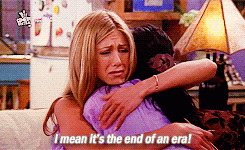
^Umayyad sovereignty be like...
Wallāda’s poetic works, while ostensibly controversial, are represented in the biography of her found in al-Suyūṭī’s work Nuzhat al-Julasā’ fī Ash’ār al-Nisā’ simply as striking; she is said to be, “unique to her age, known in her era, an embellishment to assemblies and a grace to conversations.” Despite her supposed love of risqué outfits, including one garment with which the text opens—a tunic embroidered with her lines (with some translator liberty), “I am well-suited to finer things, and as I walk I sway/ I offer my cheek to a lover, and kiss their cravings away!” –al-Suyūṭī is sure to quickly follow by telling us of her “solicitousness and integrity.” With this in mind, here are some of Wallāda’s choicer lines in which she’s breaking it off in her tempestuous fashion with Ibn Zaydūn:
Ibn Zaydūn has an anus that loves trouser staffs, Were it to spy a penis in a palm tree, It would become a bird [ṭayr abābīl] and flock to it!
And:
O, is there any way forward for us after this parting?
Lovers all around have long bewailed their fates.
Even in our winter visits, I remained inflamed, standing over passion’s embers. How, though I seemed to linger this way a while, Did the moment I feared so quickly come to pass? The nights march on without me seeing separation’s end, Nor any emancipator from desire’s bondage. God pours forth on the land you have departed Endless torrents of rain, rushing and flowing.
And, on the pain of loving him:
Wait until the shadows conceal our visit, For surely the night is good for secret trysts From you, I’ve experienced [such torment], If the sun felt this way, It would not shine The moon would not rise, And the stars would not traverse the skies.
And just for fun, on a dude named al-Asbaḥī who she clearly didn’t like much:
O Asbaḥī, rejoice, for how many a luxury has God, enthroned, bestowed you? From your own son’s asshole you’ve gotten that which Cannot be acquired from the pussy of Būrān, al-Ḥasan’s daughter!
Between the first and second of these two short poems, we essentially see the two different sides of the breakup song dichotomy. In the second poem, we get the weepy (or, per Wallāda, torrential) emotional vulnerability of a woman writing her way through a breakup with a ballad—a studied melodrama featuring all the staples (“how did this happen?” “I kept loving you though you’d grown cold,” and “I still love you, ouch, it hurts”). In the first poem, we get a breakup blast—a heavy dose of mockery, a callout by name, and a heaping side-dish of “you’re not my type anyway,” colored deeply by the taboo of male bottoming. And, even when she’s in her more emotionally volatile state, Wallāda still plays the role of exhibitionist, repackaging what she herself acknowledges as the well-trod terrain of lovers’ complaints (fa-yashkū kull ṣabb bi-mā laqī), but imbuing it with her own style. In her poem about the pain of actually *being* in love, she stages her feelings on a cosmic plane.This poem was supposedly written, according to her biography, after she had been long rejecting Ibn Zaydūn’s visits and had decided to let him back into her bed. Even when Wallāda is in a relationship, it’s her emotions alone that reach beyond the stratosphere. If there’s way in which Wallāda and Lizzo are especially kindred, it’s this interest in the reversal and the subversion that can take a love song or a breakup ballad and place the woman at the center in intriguing ways, rather than focusing on her beloved.
Lizzo
Watch the video first, folks.
youtube
Before she got nominated for, like, 1 billion Grammys, Lizzo was Melissa Viviane Jefferson. Born in Detroit, MI, Lizzo grew up across a few different cities in the U.S. (Detroit, Huston, Minneapolis, and most recently, L.A.), and long knew she wanted a career in music. In college, she studied classical flute, and she often finds ways to incorporate that into her songs, live performances, and even into an iconic scene set in the backstage area of a strip club in the film “Hustlers.” Unlike Wallāda, who is an elite insider par excellence, Lizzo comes to the world of mainstream hip-hop from the outside: she’s not from money, she’s not from the industry, and her hobbies haven’t exactly been conventionally chic and on-trend, from her long commitment to marching band flute, anime, and writing fantasy stories, to her admission in her soulful EP track, “Coconut Oil,” “I remember back, back in school when I wasn’t cool/shit I still ain’t cool, but you better make some room for me.” Perhaps most prominently, she’s a plus-sized woman who loves to sing upbeat "bops” about loving yourself as you are. Lizzo has said before in interviews that she learned to love herself and her size a while back and that it wasn’t until body positivity went mainstream and the discourse caught up to her that her music really took off and started resonating with people. One New York Times article characterizes her music as “pure gospel,” and it does often feel like Lizzo is part preacher. She closed out her Tiny Desk Concert on NPR by saying, “I just want everyone to remember, if you can love me you can love yourself […] if you can love my big black ass at this tiny, tiny desk, you can love yourself. Can I get one more hallelujah?!” But where gospel tends to be characterized by reveling in certainty—in salvation, in God, in truth—there are many moments in her breakup songs where Lizzo revels in ambivalence and reversal. Take her hit “Jerome,” which made waves with her performance at the AMA’s, the song is structured as a crooning ballad, the sort of melancholy, juicy sound you might associate with Whitney Houson’s “I Will Always Love You,” or, more recently, Adele’s “Someone Like You,” yet the refrain goes “Jerome, take your ass home/ and come back when you’re grown.” Despite appearances, it’s not a meandering ode to lost or unrequited love so much as a wakeup call about a man who isn’t complicated or emotionally torn or broken, just disappointing. Another brilliant reversal comes in the music video for her most famous breakup blast, the chart-topping “Truth Hurts,” the first line of which (“I just took a DNA test, turns out, I’m 100% that bitch”) has resulted in some controversy over possible plagiarism, as well as an endless stream of cringe-worthy riffs, including Pete Buttigieg’s (please-clap-style) attempt at relatability here:
youtube
In the video (didn’t watch it yet? scroll up, come on now), Lizzo appears bedecked in a frilly wedding dress and flanked by bridesmaids clad in robin’s egg blue, a shirtless officiant in a bedazzled hat, a groom’s party, and—conspicuously—no groom. At the line “You tried to break my heart, well that breaks my heart, that you thought you ever had him but you ain’t from the start,” another woman in the assembled crowd stands up and begins voicing the words herself, as the verse’s tension builds (“hey I’m glad you’re back with your bitch, I mean who would wanna hide this…”) the camera moves between the two women—Lizzo and the guest—culminating with them both wagging their fingers at each other and saying the line “I will never ever ever ever ever be your side chick!” Where the term “side chick” seems to unambiguously label who is at the margins of a relationship, this clever camerawork shows that when two women are both being played in a relationship, each thinks of the other as the expendable, extraneous mistress.

This critique of the “side chick” concept and the intra-female competition it signifies it something Lizzo actively contests throughout the song by emphasizing bonds of female friendship instead; in the aftermath of her breakup, her friend takes her to the salon to wash the relationship away. After all, competition over a less-than-worthy guy not only draws fire away from failings of the man (who breaks up via text in the song for crying out loud!), but also, to quote Emily Gordon, often is simply a way for women to contend with the idea of their own selfhood by pitting ourselves against a “fun-house mirror that reflects an inaccurate version of who we are.” Wallāda is perhaps finding one such fun-house mirror in her servant with whom Ibn Zaydūn has a dalliance, as mentioned above. The full poem compares Wallāda as the brilliant, close-by full moon with the servant as remote, dim Jupiter even as it acknowledges the woman’s enchanting effect on her lover:
If you only shared the passion between us,
You wouldn’t have been charmed by my handmaid
You’ve left a fruiting branch in all its beauty
And inclined toward a barren branch
Surely you’ve come to know that I am the
Full-moon of the sky, but with Jupiter,
You’ve sparked distress in me.
Meanwhile, Lizzo shows that she already has enough self-assurance and awareness to realize that she’s “100% that bitch,” even when she’s “crying crazy” in a spell of heartache, and moreover that she would rather be the player than be played. References to other prospects are strewn throughout the song, from “something more exciting,” to a “new man on the Minnesota Vikings,” to other guys “in my DMs.” Lizzo indicates that these relationships are transient, though, with the line “I put the sing in single, ain’t worried ‘bout a ring on my finger,” showing us that the most important thing after a breakup is not learning how to forgive, to support other women and recognize their pain, or even to love again in the conventional, coupled-off sense. Rather, the greatest achievement is to learn how to love and have a sustaining relationship with yourself.
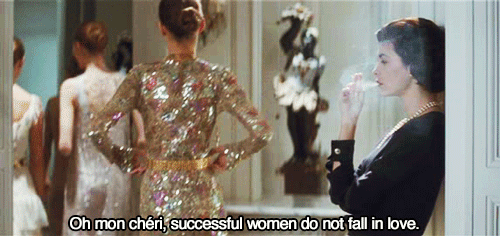
With Wallāda, self-love trickles in here and there throughout her oeuvre, but it is often articulated as a function of her status (she is high-born, beautiful, etc.) and the power and allure this enables her to exert over men. Though the breakup blast may traverse times and regions, its open celebration of single womanhood—and especially single womanhood that isn’t depicted as something fleeting, an in-betweenness rather than an identity—is far less universal and historically commonplace. Indeed, it’s still something many are uncomfortable with today, though we may be on the precipice of a change in the United States. As Rebecca Traister writes in her book All the Single Ladies: Unmarried Women and the Rise of an Independent Nation, “Many women, unmarried into their thirties, living in geographic, religious, and socio-economic corners of the country where early marriage remains a norm, as well as many women who remain single less by choice than by circumstance, into their forties, fifties, and sixties, do not feel as though they are living in a new, singles-dominated world. They feel ostracized, pressured: they are challenged by family and peers. However, statistically, across the country, these women are not alone. Their numbers are growing by the year.” Lizzo, at 31, continues to live her self-loving, single truth (and has explained that she doesn’t seek relationships out of need, but rather out of want, because she’s still at base a “single-minded” individual)—a truth that is increasingly applicable for many of her listeners. Wallāda, who never wed, would perhaps find this a welcome shift.
2 notes
·
View notes
Text
Why it was important that Rose DIDN’T own Pearl.
(I promise that there will be a positive note at the end of all this, but there’s going to be a lot of tearing down of Rose, Pearl, and Rosepearl before we get there.)
From the beginning, Pearl’s relationship with Rose was always a little troubling. Even before we learned that pearls were designed to be a slave race, and LONG before we learned Rose’s true identity as a Diamond, it was clear that there was a heavy imbalance in their relationship. The first time the show seriously examined the pairing was Rose’s Scabbard, in which Pearl learned to her shock and dismay that Rose had not been as open with her as she had believed. Not only was it heartbreaking to watch Pearl go through that experience, it was also one of the earliest signs that Rose was not the perfect figure of love and goodness that she seemed to be at first glance.
And while I do believe that Rose legitimately loved Pearl - just listen to the way she says Pearl’s name in A Single Pale Rose - it’s clear that she didn’t love her exclusively. There were more lovers in her life than just Greg. As we saw in Your Mother and Mine, she had a string of affairs with humanity dating back 6000 years. Pearl however did have romantic feelings exclusively for Rose, and that dynamic was always going to be a stressor on their relationship.
The extent of that power imbalance was significantly amplified when we learned that pearls aren’t just servants on Homeworld, they are slaves. They are things to be owned. That raised a lot of REALLY troubling questions about Pearl, her relationship to Rose, and indeed how much free will she had for herself up until the moment Steven was born. Was Pearl really a rebel, or did she just follow her master? Were her feelings for Rose even real, or just something she’d been programmed to have?
Initially, I - and I think most people - dismissed the idea that Rose had been Pearl’s owner before they rebelled. Not only was the idea nearly unthinkable, but the much more compelling theory was that Pearl belonged to one of the Diamonds instead.
Oh the irony.
So for as much as Rose’s absence was clearly painful for Pearl, it was reasonable to believe that her presence in Pearl’s life had been a net positive. Pearl’s devotion to Rose may have been colored by her nature as a Pearl, but it was still HER choice to make. For all of it’s flaws, her love for Rose was it’s own act of rebellion, a sign that Pearl truly - as she defiantly exclaimed to both Bismuth and Peridot - belonged to nobody.
...

So... yeah. Here we are now.
I really can’t undersell just how profoundly fucked up it was to see Pink Diamond - the woman Pearl loved and devoted her entire life to - sentence her to silence. Pearl has been struggling against her inability to talk about Pink Diamond for the past two seasons of the show, and possibly longer than that. It has been the primary obstacle standing between her and Steven. And it has been a perverse declaration that no matter how much Pearl grew or rebelled, some part of her will always be the same pearl Homeworld created her to be.
And that is the ultimate reason why this moment is so sickening. It’s not bad because it makes Rose and Pearl’s relationship more complicated. It’s bad because it proves that Pearl’s detractors were right.
Jasper was right when she dismissed her as “a lost defective pearl.”
Peridot was right to ask who Pearl belonged to. It was a relevant question about how she ended up on earth.
The scene is trying to harken back to an old trope where the noblewoman issues one final command before forsaking her right to rule and running off to live happily with their lover of low birth. Such a scene is inherently an act of trust on the part of the noblewoman because the recipient of the order will soon have no reason to obey it. The unspoken understanding is that it is for love of the woman and not her title that such an order will be followed. But that doesn’t work here because Pearl literally and physically had not choice but to obey. There is no trust there. If Pink Diamond had TRUSTED Pearl with her secret, then she would have asked for its safekeeping, not ordered it with an unbreakable command.
Rose hurting Pearl is nothing new (see again Rose’s Scabbard) but previous examples had always been inadvertent - failures to communicate or difficult decisions made. This is the first time we’ve seen Rose directly inflict such a terrible wound upon Pearl. If one wanted to feel charitable (I don’t) one could say that Pink Diamond simply didn’t anticipate that this command would be a source of conflict for Pearl but that doesn’t make it better. The fact that Pink Diamond said “please” does not make it better. The fact that she thought this was an okay thing to do to someone she loved AT ALL is still a massively hard pill to swallow. There’s a reason why all of the fanart of Pearl struggling with her silence depicts it as coming from an inherently villainous source. It’s the clearest demonstration to date that despite all of Rose’s high minded ideals and the lengths she went to to keep the earth safe from Homeworld, she suffered from a critical lack of basic empathy that allowed her to make some truly ghastly decisions.
Anyway, I promised some positivity and here it is: we still don’t know the whole story.
Joe Johnston has been answering questions about this moment on tumblr since I’m far from the only one who was disturbed by this scene.
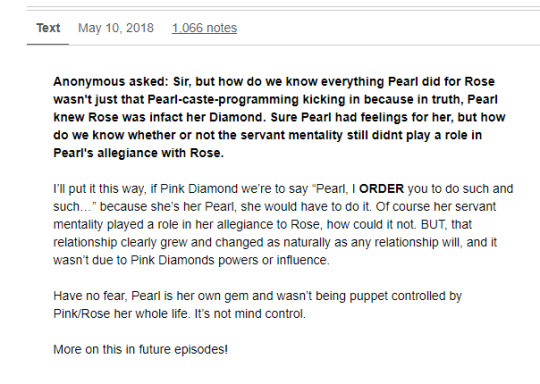
We still don’t know how Pink Diamond and Pearl’s feelings for each other came to develop. My personal hope, which has always been my preferred headcanon, is that Pearl was the first one to rebel against homeworld, and Pink Diamond followed her. Such a backstory would give Pearl back some initiative in their relationship.
Joe’s answers also confirm that Pearl really did belong to Pink Diamond which... seems like something that shouldn’t have been confirmed this early. It was plausible that not everything was what it seemed in that palanquin and Pearl was just somebody Pink Diamond had come to admire rather than her personal servant. I still find it suspicious that Pearl’s gem and general appearance point towards White Diamond instead of Pink. That addendum alone - allowing Pearl and Pink Diamond to meet as anything other than master and slave - would go a long way towards alleviating concerns about what Pearl got herself into when she fell in love with Pink Diamond.
And as for present day, since Pink Diamond was the one who had control over Pearl, that raises the possibility that Steven is able to cancel her orders, thus allowing Pearl to finally be well and truly free.
There are still paths open for Pearl to have a brighter future. Here’s hoping we get to see them.
#pink diamond#rose quartz#pearl#rosepearl#steven universe#minda watches steven universe#minda reads#in between#asks
470 notes
·
View notes
Text
Black American Wizard Origins
At the time of the Transatlantic slave trade, many magical African people were shipped as goods to what is now known as the United States. Due to the distressing nature of the trip, the rampant death, starvation, beatings, and separation of tribes and families, many did not make it to shore. However, the surviving community was able to pass down stories, ideas, and lessons in conjuring.
On most plantations, there was said to be two to four conjurers. These brave men and women took it upon themselves to make sure the traditions in magic were passed along. This was very hard to do considering most slave owners did everything in their power to make sure that the enslaved remained ignorant. The extent to which conjuring, also known as hoodoo, could be practiced varied by region and the temperament of the slave owner.
Like their ancestors, most African descended wizards received dream messengers as guides linking them to their magical ability. Upon waking from the dream, most wizards found an inscribed stone near their bed. The stone was usually brought to the conjurer and secret lessons would begin from that point.
Unfortunately, the history and knowledge of dream messengers were largely forgotten for many generations. Black wizards with no knowledge of this phenomenon have been ignoring these dreams for decades. The start of the Civil War brought about a change in group dynamics. Former slaves saw that there was life outside of their plantation homes. Promises of freedom whether gaining it by joining the military or traveling to new, often northern states dispersed familial groups and the knowledge passed down within them. It was only after the discovery of a formerly unknown wizard’s journal from 1921 that dream messaging has become popular knowledge again. The journal belonged to Ezekiel Montgomery, a freedman, who had spent a portion of his adulthood interviewing older relatives of their lives before freedom.
As we moved into the 20th and 21st century, Dream Messengers have been far less common. The African American wizarding organization, commonly known as N.A.A.A.W. , communicates mostly through the postal service and email. However, many young wizards are beginning to see a rise in dream messengers as this portion of history and culture have been revealed to them.
Plantation Life
The growing population of Black magical folk was largely missed by slave masters, simply because it started so early, in children who were often overlooked on plantations. It wasn’t until they were of a certain age that they were even considered “useful” by their owners. While some were relegated to servants in the master’s home or companions for the master’s children, most were left to be taken care of by “aunts” or “grannies”, enslaved elders that were no longer able to do hard labor. This allowed those that were being taught by conjurers to have moments alone to practice and refine their magical skills.
The course of study for most children has not changed very much over the last 200 plus years.
Originally, conjurers taught the children how to focus their magical abilities resulting in wandless magic (a useful skill as most Black children and adults often weren’t allowed much in the area of possessions), elixir/ balm making, star charting, and musical language. There was apt opportunity to practice all of these things without being caught. Many children assisted in the healing process of those around them, providing the others with elixirs to end and ward off sickness and balms to heal overworked hands, feet, and bodies that had the unfortunate pleasure of being on the other side of a whip.
Communication between enslaved Blacks became easier as time went on. The diverse group of separated Africans learned English from their kidnappers and masters. This resulted in communal growth and understanding. Much like African Americans today, the enslaved witches and wizards were able to find joy in the direst conditions. Those who showed an aptitude towards language soon discovered an ancestral magic, the language of music. Through song, dance and some instruments, the magical community realized that they were speaking a language that only the other African Americans understood. While their owners saw this as just a bit of song and dance, the enslaved people were actually communicating with the ancestors, delivering messages, and giving each other directions to freedom. “Follow the Drinking Gourd” was a popular song during this time. This magical music language continues to live on and has played a major part in the rise of the current popular music of today across all genres.
Learning to chart the stars was also an essential part of magical education taught to the young wizards. Star charting proved useful in escaping the bondage of slavery. To be able to read the night sky assured that they would be traveling the right way.
Freedom
The journey to freedom, while often dangerous to those in the southern states, was a call that many followed. Black people both magical and No-Maj headed north to freedom. Those that did make it often found pockets of freedmen and women in communities with one another. A numerous amount of people had been manumitted, some had escaped the southern states to join the rebel military, others had paid for their freedom and were working hard to pay for their families as well. Some had been born free or freedom adjacent, serving a few years of indentured servitude. As these communities of freed blacks grew, so did the swell in the population of magical Black people. Acquiring one’s own freedom led countless others to work for years to help secure freedom for those still in bondage.
To be a person of magical ability didn’t necessarily make freedom easier to acquire. Like, every other Black American, these wizards were known by one thing, the sense of otherness that comes with the color of their skin. The relationship between magical and No-Maj Black folks was and is still a fragile ecosystem. Interactions between No-Maj and wizards depend largely on the families non-magical Black people are raised in. Devout Christians have been known to be somewhat hostile toward wizards in the past since witchcraft is frowned upon (there is a growing change in recent years). Others see the practices as something deeply spiritual, a link to their culture and ancestry. Though there are differences in opinions, one thing remains the same, few people, magical or No-Maj are willing to expose each other to the governing white leaders. Protecting each other is what is most important.
Since its inception, N.A.A.A.W. has been at the forefront of Black wizard and No-Maj relations. Their work extends itself to white and Black wizard relationships as well. Bondage and racial attacks that plagued the majority of the beginnings of this nation played a major role in Black wizards keeping their magical abilities from white wizards. Since the end of Civil Rights Movement, Black wizards have slowly begun to reveal themselves and their abilities to white wizarding kind. Both the New York and D.C. chapters of N.A.A.A.W. have become fully active in larger American wizarding politics and encourage the other chapters to integrate into MACUSA.
2 notes
·
View notes
Text
character information { kaguya mori } { balmung&mateus }

The Basics
NAME: Kaguya Mori NICKNAME/ALIAS: n/a AGE: 30 RACE: Au Ra (Raen)/Miqo’te (Keeper) mix GENDER: Female SEXUALITY: Bisexual MARITAL STATUS: Single SERVER: Balmung & Mateus
Physical Appearance
HAIR: Long, jet black hair; the longest falls just to the top of her butt, the strands of hair that she wears over her shoulders fall to the curve of her breasts, and she had full bangs that fall below her eyebrows. She pulls back some of her hair into a looped bun.
( HER MATEUS-VERSE has short, wave black hair that falls to her shoulder.)
EYES: A piercing ice blue that always seem to carry a playful calm to them.
HEIGHT: 5 fulm 7 ilms
BUILD: Tall and slender, Kaguya surpasses the normal height of Auri women; she has little muscle definition, a rather ample bosom, and curves for days.
DISTINGUISHING MARKS: Her scales - and her horns - are opalescent in appearance, a rare trait that runs in her family. Because of her half-breed heritage, Kaguya has a pair of fluffy, black with red tipped Miqo’te ears. She also has sharper than normal canines; her tail is long, has scales on it, but also has fur -- akin to that of a Chinese or Japanese dragon’s tail.
COMMON ACCESSORIES: A curious looking necklace that she’s always had since she was a child.
Brief History
= Found in the middle of one of Hingashi’s many wooded areas at the age of 5 by slavers
= Sold off to a Hingan merchant, alongside a few others
Was raised and trained on how to cook, clean, and sow
When she turned 10, the merchant fell into heavy debt and she, along with the rest of the staff, were let go
= Was taken in by a friend of the merchant’s, who found Kaguya’s appearance exotic and interesting.
The man’s wife was unable to conceive children, so she raised the little girl as her own.
Taught her how to read, write, sing, dance, and play various instruments (koto, piano, shamisen)
The man’s wife passed away when Kaguya was 16, and he sold her off to another merchant.
= Her third owner - who wanted her to call him master - abused his servants - mentally, physically, and verbally.
He only kept her around because of her heritage, and would verbally degrade her for being a half-breed.
She didn’t take any of his shit, and fought back against him the next four years of her life.
= At 20, she was dragged across the ocean and to Limsa Lominsa, where she was sold off to a brothel because the man was tired of her attitude and thought that she could be broken in better in an environment like that.
= Is currently 30, and is still working at the brothel down by the docks.
Personal
PROFESSION: Former slave; sold to a brothel in Limsa HOBBIES: Dancing, making tea, reading about & studying magics, collecting little trinkets & stuffed animals, sewing LANGUAGE(S): Common, Hingan/Doman || she has a light Hingan accent RESIDENCE: Limsa Lominsa BIRTHPLACE: The Far East ( she assumes ) NAMEDAY: 12th Sun of the 3rd Astral Moon { 5/12 } PATRON DEITY: The Kami { Eorzean standard: Azeyma, the Warden } FEARS: Being told she’s not worth anything, never finding “freedom”, spiders, being alone
Relationships
SPOUSE: None CHILDREN: None PARENTS: Unknown SIBLINGS: Unknown OTHER RELATIVES: Unknown PETS: Momo (Red Panda)
Traits
extroverted / introverted / in between disorganized / organized / in between close minded / open-minded / in between calm / anxious / in between disagreeable / agreeable / in between cautious / reckless / in between patient / impatient / in between outspoken / reserved / in between leader / follower / in between empathetic / unempathetic / in between optimistic / pessimistic / in between traditional / modern / in between hard-working / lazy / in between cultured / un-cultured / in between loyal / disloyal / in between faithful / unfaithful / in between
Additional Information
SMOKING HABIT: never / sometimes / frequently / to excess. DRUGS: never / sometimes / frequently / to excess. ALCOHOL: never / sometimes / frequently / to excess.
RP Hooks
The Far East - Kaguya was (presumably) born in over in Hingashi. from what her first “Owner”/”Master” told her - when she was just a child - she had been sold off by her parents to slavers; thus is the reason why she has little memory of them and her home village.
Former Owner/Master - Kaguya was roughly 5 years old when she was first sold off by slavers to her first owner; she has spent the years - up until she was 20 - as a maid for her owners/masters. She’s gone through a handful so...
Customers - Her previous owner had grown bored of her, took her with him on business over seas, and basically sold her to a brothel in LImsa. Because of her unique looks - an Au Ra with Miqo’te features - Kaguya wound up relatively popular there.
Limsa Lominsa - It’s where she currently lives and resides, leaving the brothel on occasion to wander around Limsa and the surrounding areas.
OOC & What I Am {and Not } Looking For
LOOKING FOR:
Friends || She gets lonely, easily, and likes to spend her free time with people she feels she can trust and be friends with. She’s outgoing, and loves meeting people!
Former Owners || Since she was sold as a slave, I would be more than happy to play with someone who was her former owner/master. The Master/Slave dynamic is fun, especially when there’s varying degrees of such.
Customers || She a ho Men or women are more than welcome, since Kaguya doesn’t discriminate against gender. This also includes trans characters.
Plot || Considering she is, more or less, stuck in Limsa unless a customer pays to take her elsewhere in the world, there’s very little I can do plotwise with her. However, she wants to be free from her cage, and not spend the rest of her life chained down. She wants to learn about the past she doesn’t remember, about herself, and I want to flesh out her entire story since I have it all thought up in my head. { spoiler: HER NECKLACE PLAYS AN IMPORTANT ROLE IN EVERYTHING. }
Future/Possible Love Interests || While I’m don’t do the whole... pre-establishing a romantic relationship thing, especially so given Kaguya’s feelings about herself and relationships - I am always, always up for playing out the slow burn process of seeing how well characters mesh together. IF YOU ARE INTERESTED IN SHIPPING WITH HER please let me know and we can totally see what happens!
NOT LOOKING FOR
ERP/Smut - I’m not interest in writing out the actual details of any sexual encounters Kaguya may find herself in. Also, I’m not interested in it being pointless or without plot; she might be a courtesan, but she isn’t there solely to get someone’s rocks off. I prefer Fade To Black, and writing the aftermath.
[Permanent] Character Death || I have no plans on killing her - or any of my other characters - off permanently so this isn’t on the table, sorry.
OOC
My availability is open at the moment, given I am out of work and looking for a job.
I prefer to roleplay via Discord (message me for it), as I can focus on replies there, but I am not opposed to in-game rp. It’s just a personal preference.
When it comes to roleplay, I have a habit of writing long responses, and go the para-rp route; however, I can adapt to any play style, and match my RP partner relatively easily. I’m just a tl;dr person by nature I’m so sorry.
I’ll write just about anything as long as it isn’t the aforementioned erp/smut, or anything that deals with my characters death; I also won’t write extreme gore, or vore. But I will more than welcome dark themes in roleplay.
Please note that I am a very casual player when it comes to Final Fantasy 14, and that I do not always feel up to roleplaying. My mood fluctuates, and I can go a handful of days without replying ( which is why I prefer Discord for RP ). This does not mean I’m not interested. I AM. I just need to give my brain a break.
21 notes
·
View notes
Photo
[ID: a twitter thread by XIRAN, Chinese History Educational Memer, @.XiranJayZhao. The tweets read:
decided to do a separate thread for this so here we go: how Song dynasty poet Lu You poem-liveblogged his descent from cat owner to cat slave 800 years ago The year is 1183. Down On His Luck scholar-official Lu You gets a cat because rats keep munching on his books. 1/?
[image: a poem in Chinese, translated to English. “Poem For My Cat 1 by Lu You (1183, age 58) I got a little Kitty with a bag of salt To protect the countless books in my study It’s just a shame my family is poor and my wages low So it has no rug to sleep on or fish to eat”]
the effects are GREAT!! Lu You is delighted!! THIS IS LITERALLY THE TITLE HE GAVE THE POEM I AM NOT MAKING SHIT UP (also feel free to correct my translations because my classical chinese is not that good LOOOL) 2/?
[image: a poem in Chinese, translated to English. “Rats Kept Ruining My Books So I Got a Cat and Within Days the Rats Were Vanquished by Lu You Conscription has left the house empty Only my cat keeps me company It’s so soft to touch and warm to hold in bed So brave and capable that it has ousted the rat nest As valiant as the soldiers slaying enemies on the battlefield I cannot give it much fish to eat, but it does not mind Nor does it waste time catching butterflies among the flowers”
several years later, Lu You gets ANOTHER CAT!! he calls it Snowy!! (probably had white fur then) he loves it so much he suspects it was a child of his reincarnated from a past life 3/?
[image: a poem in Chinese, translated to English. “I Got a Cat From a Nearby Village That I’m Naming ‘Snowy’ by Lu You (1191, age 66) It looks like a tiger and can climb trees It acts as if a horse but can’t pull carts Even though it has vanquished the rat’s nest It has no demand for fish as meals Every so often it gets drunk off catnip Every night it warms the rug It must have been my child in a past life Reincarnated here to keep me company in my old age”
and then cat #3, Pink-Nose!!! it seems that Lu You's cats have fish to eat now, but Pink-Nose seems to be slacking on its mice-eradicating duties...? 4/?
[image: a poem in Chinese, translated to English. “Poem for Pink-Nose by Lu You (1193, age 68) Night after night you used to massacre rats Guarding the grain store so ferociously So why do you now act as if you live within palace walls Eating fish every day and sleeping in my bed?”]
the power dynamics in the Lu household now seem to be experiencing some shifts. who is the master and who is the servant now?? 5/?
[image: a poem in Chinese, translated to English. “Poem for My Cat 3 by Lu You I do not reprimand you for not catching mice I still serve you fish on time Every day I see you sleeping without worry So for what reason do you keep running here and there?”]
it finally hits Lu You, what has happened. he has made a terrible mistake, spoiling his cats so much. they're not working anymore. there is no going back. this is his life now. a life full of rats and birds his cats refuse to kill. 6/?
[image: a poem in Chinese, translated to English. “Some Thoughts by Lu You My cat is sleeping in my bed, not caring how rats are rampaging My books are getting ruined and birds wake me before dawn I cannot believe this was all a ruse to get food from me It is so lazy now that it is warm and safe Impossible to train when it has a full stomach I was so naive and now I’m so stressed out”]
does this mean Lu You hates his cats now? naaah, son, he has accepted his fate and cuddles with them on stormy nights like the full-fledged cat slave he is 7/?
Quote Tweet by @.XiranJayZhao: you think humans have fundamentally changed during the past thousand years?? wrong. here is a very relatable poem written in 1192 by Song dynasty poet Lu You (who was 67 when he wrote this so i need you to imagine that too when you picture the poem)
[image: a poem in Chinese, translated to English. “A Rainstorm on the Fourth Day of Eleventh Month (1) by Lu You (1192) Wind sweeps the wold and rain darkens the village, Rumbles roll off the mountains like ocean waves churning. The furnace is soothing and the rug is warm, Me and my cat are not leaving the house.”]
RELATABLE STRUGGLES AS IM TRYING TO DO THIS THREAD)
[image: a photo of a grey kitten pawing at a laptop screen open to Twitter]
anyway if you noticed there's no Poem For My Cat 2, it's because it's technically this one that I translated for my post yesterday, but I can't quite place its timing in relation to the others
[image: a poem in Chinese, translated to English “Getting a Cat by Lu You I traded a bag of salt for a cat I often watch it playing by my chair Every so often it gets drunk off catnip Every night it hogs my pretty rug It has ousted a nest of mice How could I not give it a feast of fish? I should give it a name now I’ll call it Little Tiger”]
and there's one final poem but i'm so bad at translating it that I gave up loool. just know that Lu You was in a position where he'd be sad and lonely but he wasn't because he had his FAT CAT with him
[image: a poem in Chinese with a work-in-progress translation into English “Sitting Alone At Night [Something about not seeing his friends in a long time and having nowhere to express his political opinions] Listening to the rain, I put on robes as rugged as a monk’s Lighting a lantern, I sit by a hearth Feelings of loneliness do not arise in me When I have my fat cat as a companion”]
Filing this under How People Lived in Ancient China twitter.com/i/events/12917… Hope you enjoyed these 800-year-old cat liveblogs😂 More Chinese history tweets: http://linktr.ee/xiranjayzhao
OH and I gotta add that in modern China, cat owners really are called Cat Slaves 猫奴 or Poop Shoveling Officers 铲屎官 (which implies that the cat is the emperor) 🥴
End description]
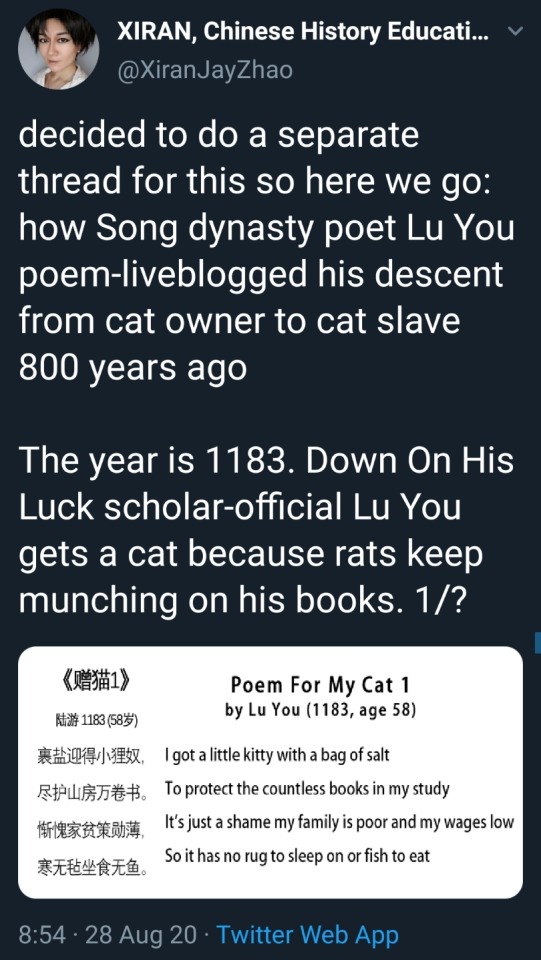
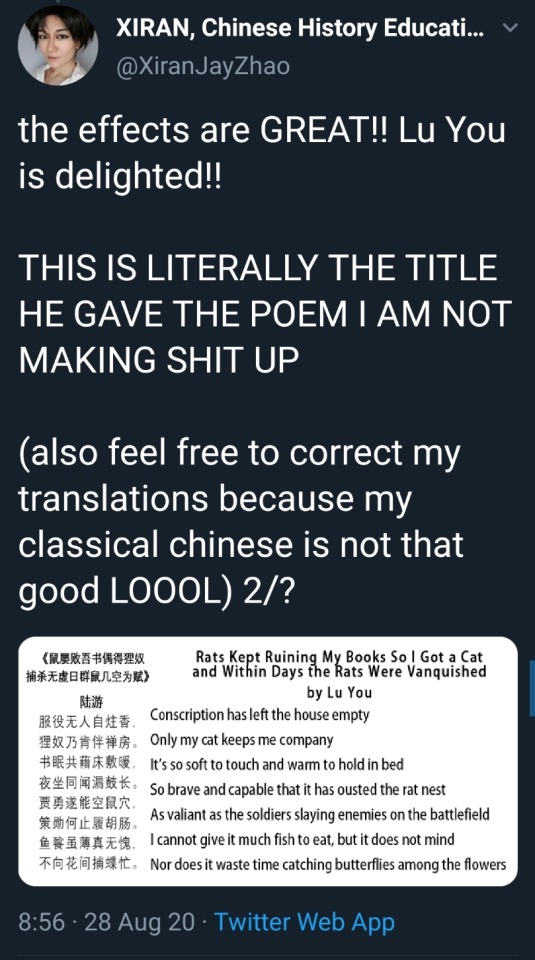
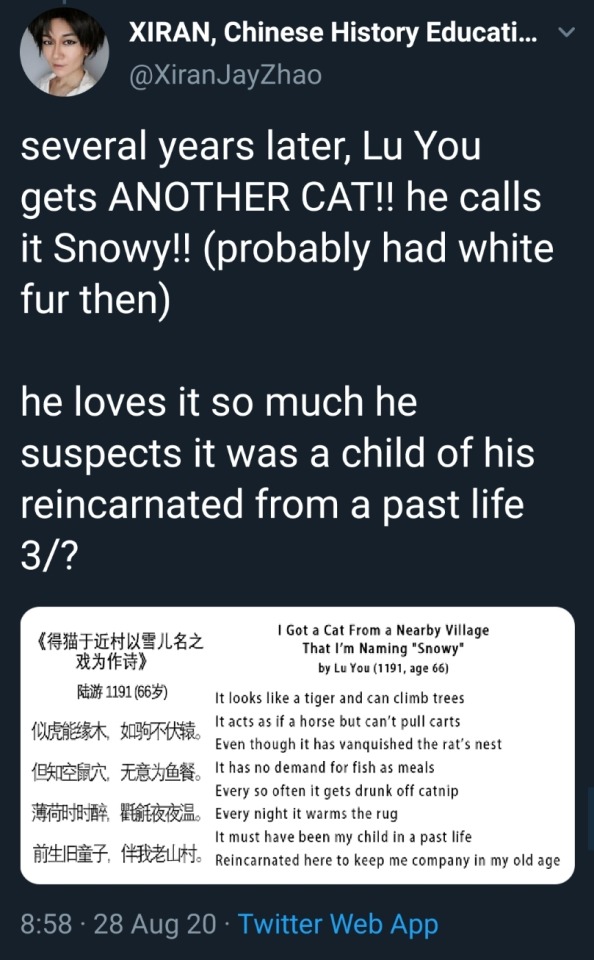
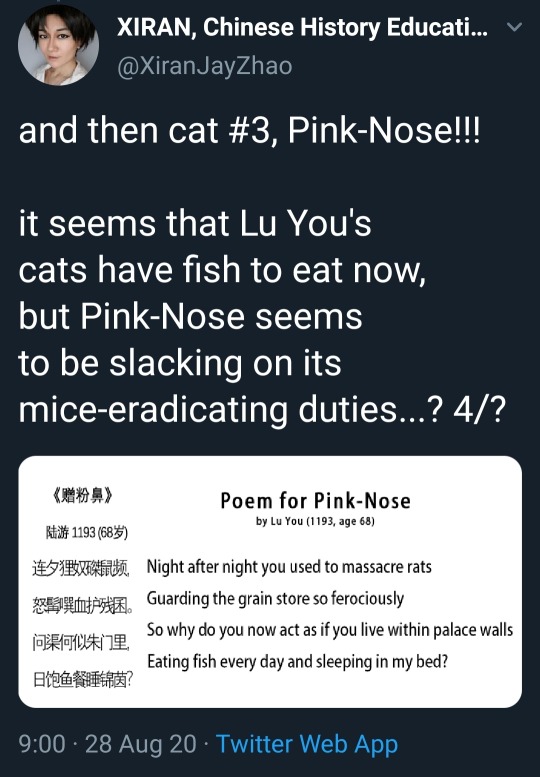
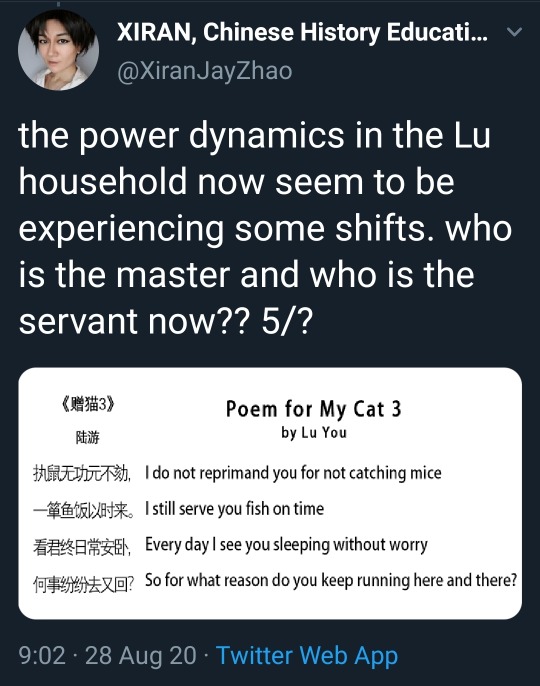
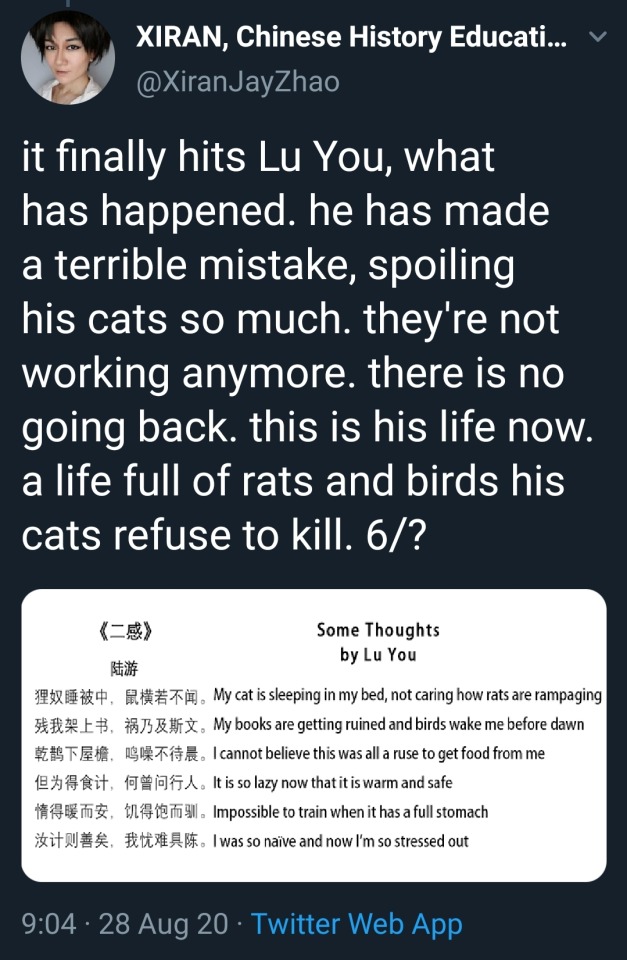

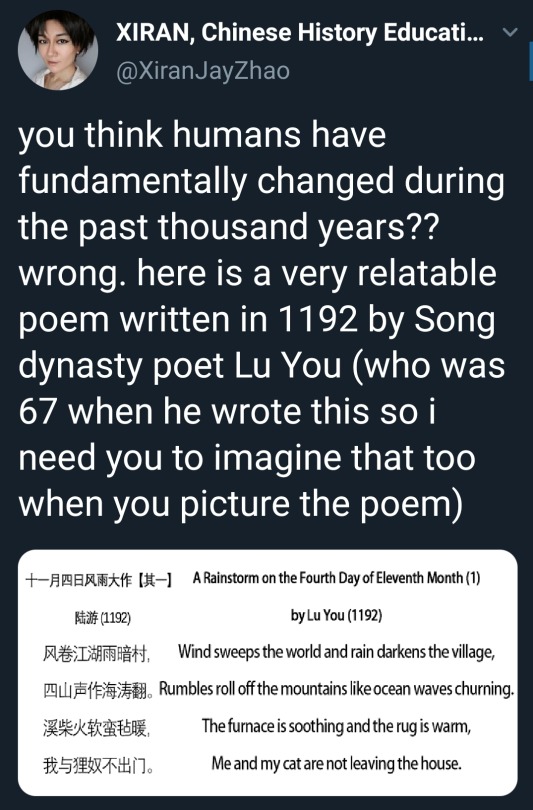
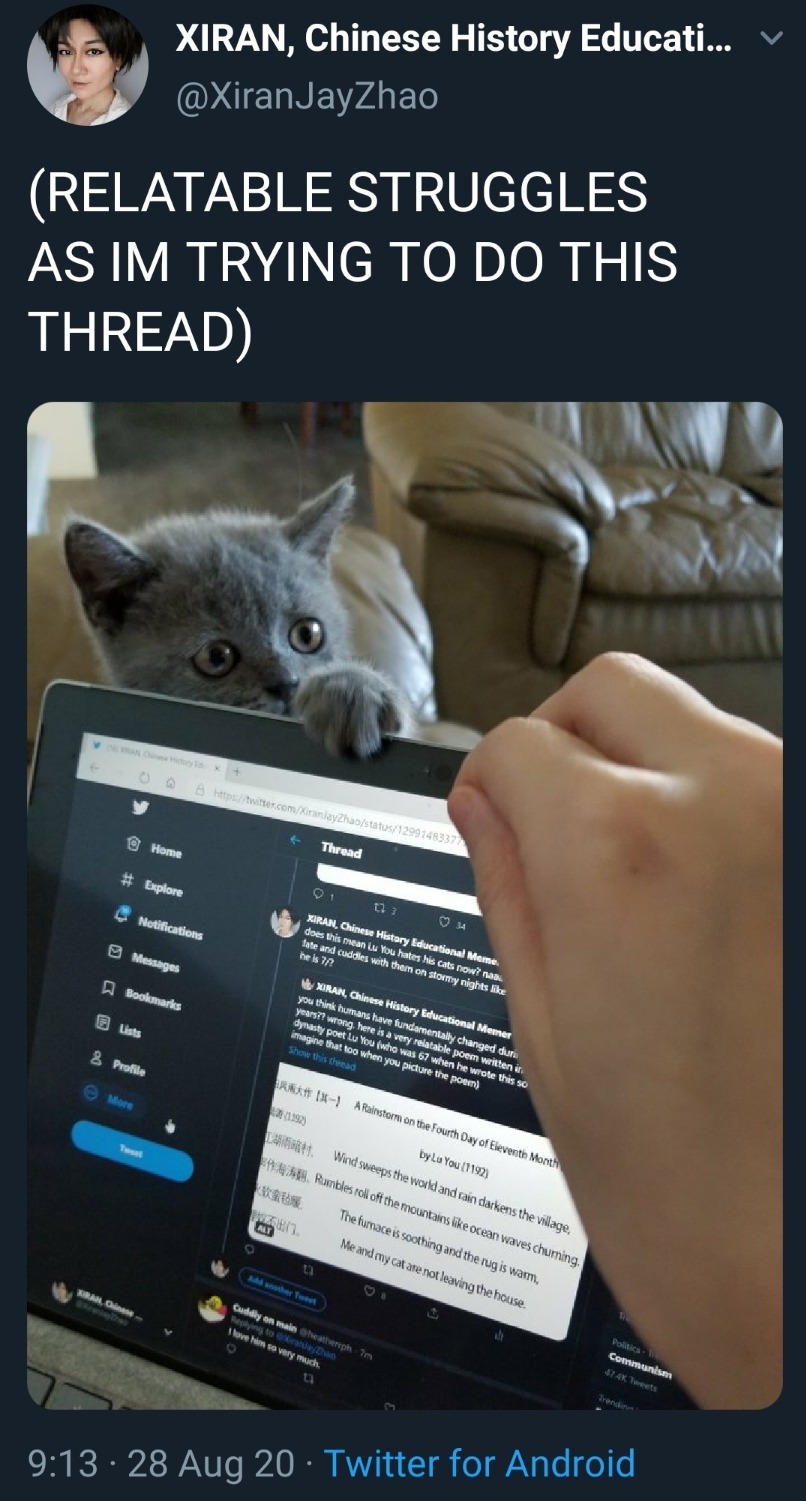
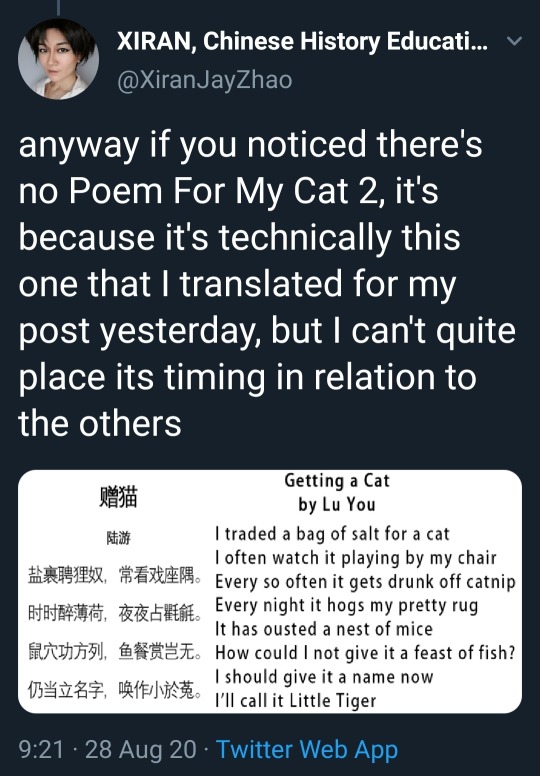
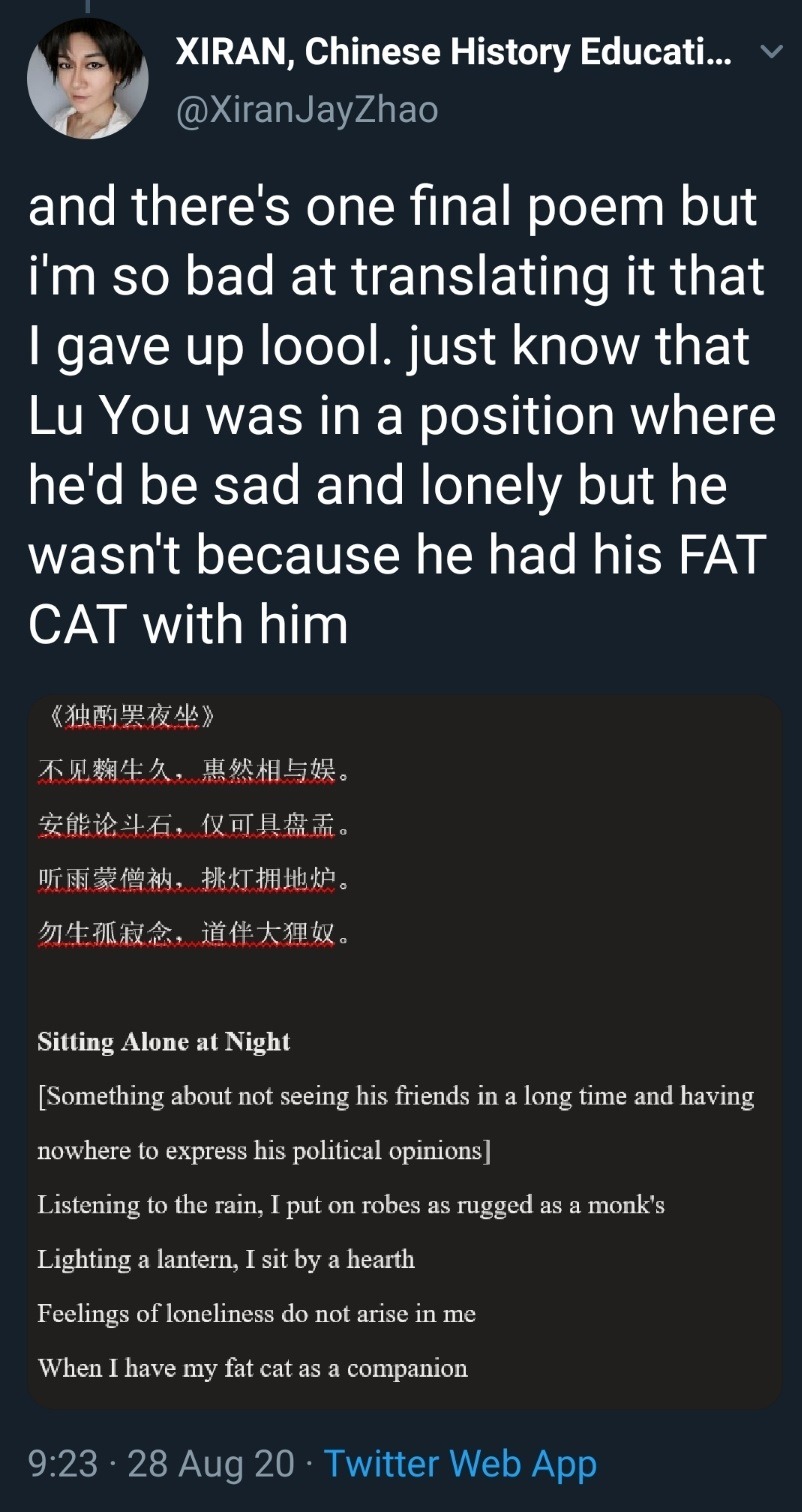

[Source]
28K notes
·
View notes
Text
Cape Breton lobster: The marketing, the history
Chris Bellemore
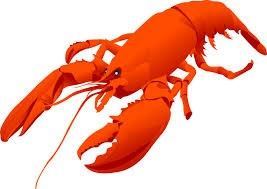
Lobster is king these days in Cape Breton waters and throughout the eastern seashore. Although Maine has been the focal point for lobster this last century due to marketing and early access to global distribution channels, Cape Breton and the rest of Atlantic Canada are thriving based on demand from new markets. Like any other product that has ever existed markets change and fluctuate, creating times of bounty and times of hardship. There is a long and diverse history related to lobster that I’ve been delving into over the last few months.

Lobster fishing boat in Main-à-Dieu. Photo Credit: Tom MacDonald courtesy of Google Maps
The Early Years
Lobsters were plentiful on the east coast for hundreds, if not thousands of years. There are reports of lobsters being washed up in the beach during low tide, and after storms, sometimes in piles two feet high. It is said that the Mi’kmaq used lobsters for food, to fertilize their crops and to bait their fishing hook, and sometimes used the cleaned and polished lobster claws as tobacco pouches and even as pipes (from The Spirit Sings, Artistic Traditions of Canada's First Peoples 1827-29).
In his journal entry referencing Cibo (Sydney), Nova Scotia from 1597 English Captain Charles Leigh wrote that "In this place are the greatest multitude of lobsters that ever we heard of; for we caught at one hawle with a little draw net above 140."
References to how lobster were fished during these early times stem from collection by hand along the coast, hook and line dragging, the use of a spear as well as dragging nets in shallow areas. As colonists occupied more of the eastern shore and lobsters became less available practices switched to basket designs brought over from France and specialized hauling boats called smacks. It wasn’t however until the mid 19th century that lobster traps, as we know today, became a more popular way of harvesting as fishing operatord found more success in deeper waters.
Due to their sheer abundance lobsters became a precious source of sustenance during hard times, which gave them a nasty reputation as the poor man’s protein, being labelled regionally as “the rat of the sea”. There are widespread references that lobsters were routinely fed to prisoners, apprentices, slaves and children during the colonial era and beyond. In one Massachusetts town, a group of servants became so upset at their lobster-heavy diet that they took their masters to court and won a judgment protecting them from having to eat it more than three times a week. Afterwards servants allegedly insisted on stipulations in their contracts that they would only be served the shellfish twice a week.
Although widely spread, it is a common misconception that the average European during the colonial period had a distaste for lobster and would not eat it. Revered maritime historian A. J. B. Johnston in his paper The Early Days of the Lobster Fishery in Atlantic Canada references several Cape Breton accounts of Europeans enjoying the taste of lobster, including explorer and trader Nicolas Denys, accounts by French Governor General’s secretary Thomas Pichon, as well those of invading New England soldiers during the siege of Louisbourg.
Johnston also references lobster fisheries in coastal France and lobster markets in England as further evidence that even upscale Europeans were eating lobster and were not just eating bologna, as one local Cape Breton radio host mentioned some time back. Perhaps, just like today, it came down to personal preference during various periods of our long history.
Despite early interests the perception of lobster as a food for the poor persisted into the 1800s. “Lobster shells about a house are looked upon as signs of poverty and degradation,” wrote American observer John Rowan in the mid-19th century. Peddlers in Portland, Maine carried lobsters around in wheelbarrows, selling them on the street to working class Irish immigrants.

Although Nova Scotia holds the record for the world's largest lobster caught in 1977 and weighing 44 lbs, it also used to be home to the world's largest lobster trap in Cheticamp that stood until the 1990s. There has been some recent talk about bringing the largest lobster trap back. Photo credit: americansguide.ca
The Start of the Lobster Industry
Lobster first appeared on menus in the 1850s and 60s as a bargain dish in the salad section of stores. The going rate was half that of chicken salad. Accessibility to lobster was still mostly limited to coastal communities. That changed with the invention of the stamp can in 1847 which allowed food to be stored for future use. Canneries soon followed.
Early canning started in Maine and then spread to the rest of the Atlantic seaboard.The first Cape Breton canneries opened in Richmond County in 1872 and then in other parts of Cape Breton the following year (Nineteenth Century Cape Breton: A Historical Geography Hornsby 1992). At first the canners had difficulty convincing fishermen to catch lobsters and an even harder time persuading shop owners to buy the canned goods, but they soon realised the market for a low-cost protein food that could be stored and transported. Soon the canneries dotted the landscape of most coastal communities, creating much needed jobs and a thriving industry.

Early packaging label from Aspy Bay, Cape Breton that includes a recipe for lobster curry! Photo Credit: Nova Scotia Archives
After changing the landscape and dynamics of small fishing communities for thirty years, the canning industry eventually waned across the Atlantic seaboard. At a time where lobster fishing was vastly unregulated the resource dwindled due to increased pressure from industrial processing. In the beginning about one to two lobsters were needed to fill every one-pound can. Lobsters used for manufacturing were around 3-6 pounds each while the smaller lobsters were simply thrown back. Just ten years later fishing practices became so aggressive that lobsters couldn’t survive long enough to grow beyond two pounds. Now it took ten or more younger lobsters—many which had never reproduced— to produce a one-pound can. In a nut (lobster) shell, the cost of shelling outweighed the profits, pushing most small canneries out of business.
As the canneries struggled other opportunities emerged by the 1890s. With increased accessibility to markets the lobster started to shed its notoriety as a lower class food, gaining a following among upper class diners, particularly in Boston and New York City. Tourists to the east coast in search of unique experiences elevated the lobster further, finding a new appreciation for the one to two pound lobsters that now fit nicely on their dinner plates, and were willing to pay top dollar. New methods of refrigeration and ice packing allowed fishermen to ship live lobsters inland as far as Chicago, St. Louis, and even to England, where they sold for ten times the original price. As supply struggled to keep up with demand the prices for lobster went through the roof. Between 1889 and 1898 average per-pound prices quadrupled, then jumped again in 1905 (The Lobster Coast, Woodward). Only the ever-increasing prices kept an environmental disaster from occurring from overfishing.
The market remained strong up until the Great Depression in the 1920s, when most could no longer afford the dish in restaurants. Canneries had a revival as there was once again the need for a cheap source of protein for the population, including military troops. After the depression the market rebounded as lobster had instilled itself as an upscale, fancy meal that families could partake in from time-to-time. Interest continued to rise through the 1950s and 1960s. As the rise in the market for live lobsters in the United States the canneries started to disappear once again on the landscape, and canned lobster eventually was gone from most of the Maritimes. There is a great article in Cape Breton’s Magazine about lobster fishing in Cape Breton (Main-a-Dieu, Mabou, Grand Etang) up to the 1950s and 1960s: http://capebretonsmagazine.com/modules/publisher/item.php?itemid=739

Co-op lobster canning factory in Grand Etang circa 1940 from Cape Breton's Magazine

Packing lobster in factory near Cheticamp ca. 1959 - NS Archives
The prices at market haven’t always demonstrated a net benefit to local fishermen, most notably in 1909, when fishermen tied up their boats and went on strike for better prices from canning companies. This, in itself, was a strong demonstration of early organisation and cooperation among the fishing community in the early years. Unfortunately, at the time, communities that did not give up and give in suffered greatly. The American canning company Burnham & Morrill mothballed its factory for the 1909 season leaving no one to buy Gabarus lobsters. The fishermen in Gabarus responded by establishing a cooperative cannery in Gabarus Bay at the now abandoned community of Gull Cove. All-in-all the price for giving up valuable days on the water to strike resulted in no price increase but a promise of a government inquiry. (Historicizing the Lobster Fishery Tie-Up, Morton, 2013). Another tie-up happened more recently in 2013 where fishermen negotiated a modest increase in lobster prices.

Gull Cove lobster factory. circa 1951. Although the community has been abandoned for many years, the stories persist. Photo credit Albert Albie MacDonald
Present Day
Today the lobster fishery is just as volatile as it ever has been. The success of the industry not only depends on the success of the resource, but also market competition and positioning; all playing out on a global scale.
China has become a significant player in recent years with their growing middle class that wants the best that the world can provide delivered to their doorstep. In 2016 Nova Scotia exported more than $218 million worth of seafood to China. It is expected that this market will continue to grow as China invests in more processing plants and has lowered tariffs this year.
The marketing piece is one of the most intriguing elements. There has been ongoing, often ravenous competition between the powerful marketing of Maine lobster and cheaper Canadian lobster. The topic even became part of the mainstream in 2009 with celebrity chef Gordon Ramsay on his show Kitchen Nightmares, where he vehemently scolds an establishment for substituting Maine lobster for Canadian lobster. He harnesses some sort of super-power that allows him to detect the difference by sight (https://www.youtube.com/watch?v=mkSR7ExMDPc ).

This was quickly followed up by the emergence of Fourchu lobster, the proclaimed “Rolls Royce of Lobsters” that gained traction in 2010-2011 due to the extraordinary efforts of Dorothy Cann Hamilton, the founder of the International Culinary Centre. She claims that their exquisite taste is because “they're raised in exceptionally cold and clear water, so they grow slowly, and they're harvested before molting, so their meat is firm, with a complex taste that's not overly sweet.” The lobsters were transported to New York City for distribution to several upscale restaurants. http://gothamist.com/2012/05/30/test_driving_the_rolls_royce_of_lob.php#photo-1
With any product these days it is very difficult to sift through the smoke and mirrors.What people care about is the taste, the story behind the product, the ethical practices that are employed, and, of course, the cost. But we are all being constantly manipulated in these areas and much is often romanticised to some extent in the name of big business. As Mary Roach points out in her 2013 offering Gulp, taste is subjective. “It’s ephemeral, shaped by trends and fads. It’s one part mouth and two parts ego”. This holds true with perceptions of lobster in the 18th century or in the present day. She goes on to point out that studies conducted with wine and cost, and how, during blind taste tests with experts, least expensive wines regularly outscore the more expensive ones and often the most expensive wines score the worst.
So perhaps the low cost is driving Ramsay’s distaste for Canadian lobster. Perhaps it is something more that speaks to the preferences and acquired tastes of a broader group of consumers. I'm inclined to think he was paid off by the big Maine marketing machine that year. What is clear is that marketing is big business and will continue to be a key driver in the success of our industry and a resource that has helped to define our coastal communities.
Other Sources:
The American Lobster. History of Lobster Fishing and Processing. http://www.parl.ns.ca/lobster/history.htm , 2017
A Taste of Lobster History. http://www.history.com/news/a-taste-of-lobster-history . 2011
I dedicate this article to David Bull, a dear friend that passed away this year. He was instrumental in rejuvenating my interest in culture and history after being subjected to too many school trips to the local museum that involved hours of watching someone churn butter.
Chris Bellemore is a blogger from Ontario that moved to Cape Breton Island and is logging his experiences in this strange and wonderful place. The good, the bad and the ugly. "You see, in this world there's two kinds of people, my friend: Those with loaded guns and those who dig. You dig."
My life in a nutshell, with most of the bad parts cut out:
Other related articles:
The WW2 plane on top of Jerome Mountain, Cape Breton https://capebreton.lokol.me/the-ww2-plane-on-top-of-jerome-mountain-cape-breton
The last schooner in Margaree: https://capebreton.lokol.me/the-last-schooner
My music that I work on, sometimes with a few friends:
https://soundcloud.com/crispbellemono Trust me on this. From what the statistics tell me I'm a big hit in Bangladesh and Wales.
#lobster#cape breton#canada#history#fisheries#maritimes#seafood#nova scotia#gordon ramsay#atlantic#maine#marketing
2 notes
·
View notes
Text
12 Years a Slave
Chiwetel Ejiofor plays the role of Soloman Northup, a free black man who was captured and enslaved for twelve years, hence the film’s title, 12 Years a Slave. There are multiple examples throughout this film of social class difference based on race, enhancing power dynamics, and how intersectionality can affect the way one’s treated. The plot follows how Solomon is kidnapped into slavery and fights to gain his free man status back. His story is contrasted to characters, Epps, Patsey, and Bass.

Soloman Northup kidnapping location (Britannica).
Soloman’s downfall begins when he is kidnapped and sent to New Orleans to be a slave named Platt. Epps is the second slave owner that Soloman is owned by. He uses his white power to get his slaves to do what he says, or he will beat them. He goes so far to threaten to kill Soloman and brutally whips Patsey to near death. Epps uses his power over one slave, Patsey, to repeatedly rape her and allow his wife to humiliate her often. Patsey, being a female slave, experiences more hardships as a result of her intersectionality than Soloman. Patsey is held to a higher standard because she picks twice as much cotton a day but is sexually abused because she is a woman. While Soloman is safe from sexual abuse, his little power is made to seem smaller in relation to the indentured servant, Bass. Bass, a white man, feels compelled to explain to Ebbs that slavery is unjust and supports his opinion by stating his Christian beliefs. Ebbs strongly disagrees but does not beat Bass because he is not his property, like Soloman is. Bass is allowed the freedom to express his opinion without life threatening repercussions from Ebbs. The cultural differences between these characters are expressed throughout the movie and these are just a few examples.

Soloman and other slaves standing in sugarcane field listening to their master (12 Years a Salve).
This movie shows a segment of Solomon Northup’s life directed by a black man, Steve McQueen. Deborah Willis discusses the way black people are represented differently through the lens of white people and black people in the 20th century. Willis reflects on discovering a photography book created by a black man, “The lighting in the photographs was dramatically dark and realistic...the photographs spoke to me in a manner that I will never forget” (Willis, 4). This rare instance of Deborah Willis seeing her people being represented in good lighting and with accuracy made her more confident. The way a story is told effects how people perceive it. Similarly, 12 Years a Slave is directed by a black man which allows the story to be told in a profoundly empowering way rather than a sad, depressing point of view. Soloman Northup also wrote this story from his point of view as a black man and from 1853-57 he traveled to speak about abolition and his kidnappers were indicted in 1854. However, Soloman’s word could not hold up in court against a white man’s, so while they were guilty Hamilton and Brown were released; emphasizing the white privilege they had (Britannica).
Cole, Rachel. "Solomon Northup | Biography & Facts". Encyclopedia Britannica, 2021, https://www.britannica.com/biography/Solomon-Northup.
McQueen, Steve. 12 Years A Slave. Brad Pitt, 2021.
Willis, Deborah. Picturing Us, 3-26. The New York, 1994.
0 notes
Photo

Scrum Master Certification
An excellent Scrum Master has to possess these top rated soft capabilities to work in their own role. The checklist is certainly not comprehensive, please don’t hesitate to add more in the comments.
Communicator - that the key function is communicating and using communicating to accomplish things. The Scrum Master is constantly relieving meetings and forcing a schedule. Without strong communicating skills this really is difficult.
Listener - Scrum Masters should perfect the capacity to listen in par two and one. Not merely do they will have to trace what’s happening from the job and also restrain bounds of job to be performed, but in addition they will ought to listen to impediments.
Persistent - that the Scrum Master is your process Gate Keeper. We are all aware that a lot of people is anti inflammatory change, therefore the Scrum Master’s constant behaviour in getting visitors to collaborate is vital.
Facilitation - an excellent Scrum Master has to have mastered the art of facilitation. It’s unquestionably a critical component within the total success of your self in addition to your own teams. Keeping meetings track, recorded and ensuring outcome calls permanently facilitation.
Accountability - a Scrum Master is fundamentally in charge of its shipping procedure, therefore the individual should be aware of that the dynamics across RACI associated each role. This job makes sure that the others require responsibility and also steps to act that if demanded.
Servant Leader - that the Scrum Master (and some other boss in a agile company ) is really just a slave leader of course and natures this caliber in the others on the team. Providing individuals with all the distance and possibility to emerge as a pioneer is a essential portion of a leaders part from the corporation.
Negotiator - this job will always be getting together with all the item owner and also the team, also has to safeguard the team by carrying on a lot of effort, and additionally shield the item owner out of under-commitment from the Sprint. This takes great discussion skill.
Knows just how to take care of battle - in that role there’ll be times if you’re required to step in the heat of this minute and get return with their mature countries. Recognizing not to take to neutralize the specific problem is essential.
0 notes
Text
Those ‘Black Confederates’ We Hear About
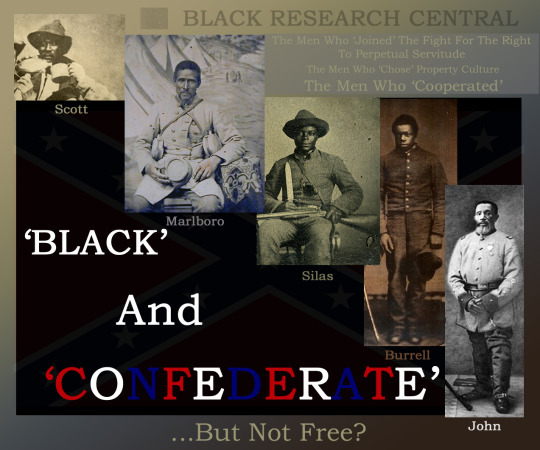
Black People in the American Civil War
by Admin Om
Black men were not officially allowed to serve as soldiers for the 'Confederate States of America' until very late in the Civil War, specifically through a bill passed by the Confederate Congress on March 13, 1865. Even then, freedom was not guaranteed to those who did fight on the Confederate side as it had been for the nearly 200,000 who became soldiers in the Union army.
Prior to this, blacks in the 'Confederacy' served in other roles such as hard laborers, camp servants, or body servants (slaves who were often brought into battle by those who claimed their ownership). Until January 1, 1863 when President Abraham Lincoln declared in the Emancipation Proclamation that "[free and newly freed] persons of suitable condition, will be received into the armed service of the United States," blacks on the Union side also served in those roles outside of battle.
These are the stories of a few of the black men who served with the Confederate army...

Members of the 57th Georgia Infantry, Company H - From Left To Right: First Lieutenant Archibald C. McKinley, Captain John Richard Bonner, Scott (enslaved by McKinley), and Second Lieutenant William S. Stetson
Scott
Scott was 37 years old when his 17-year-old slave master joined the army to defend the cause of the Confederacy. He left his wife and children behind. During the war, Scott would build his master's fires, wash his master's clothes, and serve him food (he was a cook).
When Scott heard false reports of his master's death, he cried bitterly as he went searching for his master. Union soldiers, seeing him, laughed and taunted him along the way.
Scott stayed by his master's side from the time of enlistment to the end of the war. Upon hearing news of his beloved servant's death in battle, his master wrote of Scott: "Poor fellow, he was one of the few niggers who was a friend of the whites." After the war, Scott received a house and 20 acres of land from his master's father. Scott's former slave master recorded that for the rest of Scott's life, "he was cultivating the land industriously."
You can view the company roster here.

Marlboro Jones, enslaved by Confederate captain Randal F. Jones of the 7th Georgia Cavalry
Marlboro[ugh]
Marlboro Jones was a 'manservant' of a Confederate captain. In June 1864, the captain was mortally wounded and his slave brought him back home.

Silas Chandler (right), enslaved by Confederate sergeant A.M. Chandler (left) of the 44th Mississippi Infantry Regiment, Company F
Silas
Silas knew nothing but slavery his entire life. He served his master's family since the time of his birth. They would hire him out around the local community. Just prior to the war, Silas entered into a slave marriage with a woman named Lucy, whose mother Polly was a mulatto house slave and whose father was an unidentified slave owner. She was the product of an "illegitimate relationship.”
Out of 36 other plantation slaves, Silas was sent by his master's mother to join him in defending the cause of the Confederacy. When his master was wounded in the leg, Silas joined him at the makeshift hospital where he was taken. The surgeons decided the leg could not be saved and were determined to amputate it. However, Silas refused to allow them to carry out their operation. To this, his master's family was grateful. At the time, Silas was 26 years old while his master was 19.
According to a descendant of the family, Silas "managed to hoist his master into a convenient boxcar." Silas later joined the war again to defend the cause of the Confederacy with his master's brother, who would be his new master for the remainder of the war. During this time, he would join his master in defending the president of the ‘Confederate States of America’ and his entourage as they fled federal forces. Three days after their escort was disbanded, they both surrendered as did the Confederate president. After the Civil War, Silas continued his profession as a talented carpenter, notably working to build a Baptist church with other freedmen. Silas, along with 1,739 men of color, received a state pension for his service through a program that began in 1888. He passed away in 1919 at the age of 82.
Learn more about the history behind this photograph here and here.
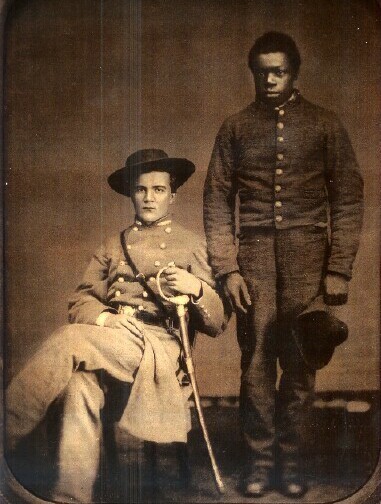
Burrell (right), enslaved by Confederate sergeant John Wallace Comer (left) of the 57th Alabama Infantry Regiment
Burrell
Burrell's master was the brother of the governor in his state. He was just one of about 60 slaves on the plantation. At 16, he joined his master in defending the Confederate cause. In one battle, when his master was injured, Burrell braved enemy fire to drag him to safety. He then brought his master to a boat and rowed him about 260 miles to his mother, so that he could recover. His master would remark in a letter that his slave was too valuable for him to sell.
But Burell's slave master also had this to say of his dear partner: "Burrell was not really a soldier. He was still a ‘Negro'." After the war, the formerly enslaved Burrell got a stipend from the state for his service.

John Terrill (right), enslaved by J. B. White (left) of the 6th Tennessee Cavalry, Company D - John served as an escort on the staff of Brigadier-General James Ronald Chalmers.
John
John accompanied his master, a Confederate brigadier general in defense of the Confederate cause. Years after the Civil War, he became a doctor for the local black community.
Not all black civilians living in Confederate territory were excited about defending the way of life in the south.
William Makepeace Thayer (1820-1898), a Congressional Clergyman, recalls a conversation with such a slave:
“'Tom, they tell me that you won’t fight if you do enlist; and that you love your masters so much, that, the moment you meet them on the battlefield, you will throw down your own arms, and rush into theirs. Is that so?’ Straightening up with a new sparkle in his eyes, Tom answered, ‘Lieutenant, I know dey says dese tings; but dey lies. Our masters may talk now all dey choose; but one ting’s sartin, dey don’t dare to try us. Jess put de guns into our hans, and you’ll soon see dat we not only know how to shoot, but who to shoot. My master wouldn’t be wuff much ef I was a soldier.'"
When analyzing the ‘patriotism’ of blacks throughout the Civil War towards the so-called Confederate States of America, the relationship between masters and slaves in the Antebellum South, cannot be undermined or ignored. The significance of this social dynamic that existed in the southern states between the white men and black men is such that any discussion on Black Confederates without taking this into consideration is devoid of any real context. The question of whether or not Black Confederates existed is not so much a question of if the rebelling states had any black men within their ranks, but rather, a question of whether or not any of the men pictured above were in a situation that was any different from the child pictured below.

This photo by Confederate photographer A.J. Riddle from the collection of David Wynn Vaughan was on display at the Smithsonian's National Portrait Gallery in Washington, D.C. in April 2013.
Read More about it here.
So...Were There ‘Black Confederates’?
Yes. They Existed, Sure.
There were reports of black regiments as well.
Even while Frederick Douglass wrote about the Battle of First Manassas in the August 1861 issue of his newspaper, Douglass’ Monthly that there were “real soldiers”, he also wrote of them what he believed was the only reasonable explanation for their presence...
...among rebels were black troops, no doubt pressed into service by their tyrant masters.
According to The Root:
They made up less than 1% of the 800,000 black men of military age (17-50) living in the Confederate states, based on 1860 U.S. census figures, and less than 1% of at least 750,000 Confederate soldiers.
But while some chose to be soldiers (if not pushed into doing so), did Black People ever choose to become Black Confederates?
Here, we see the undeniable truth. All the debating in the world cannot replace the answer that this photo clearly presents before the eyes. For many, it was very clear they had no option.
What were some of the factors that might have led to a decision for assisting in the Confederate efforts?
Can we find some of those factors in the face of the unknown body servant standing behind the Confederate captain?
Did regular black boys and black men somehow sign up to be someone’s slave just to be part of the resistance against “oppressive federal infringements” on the free rights of southerners? Was this assigned role somehow the ticket to being a soldier in the Confederate army if you were black or is there more here?
There is no escaping this fact: Scott, Marlboro, Silas, Burrell, and John all stood in the place of that young unknown body servant. They had as much of a choice in lifting a gun to their shoulders in the presence of their masters as that child did. They helped whenever they could around the house, on the plantation, at camp, and in the field. But there was always someone they could never help wherever they went and no matter how far they would have gone in their service for the cause of white supremacy: they could never help themselves.
They could not help themselves to the first fruits of their own wealth as they toiled to secure the wealth of their white masters. They could not help their own families to safety while they were out there risking life and limb for their white masters and their families. They could not even be men. How then could they be warriors?
For some time, this was also the case for the blacks in Lincoln’s army.
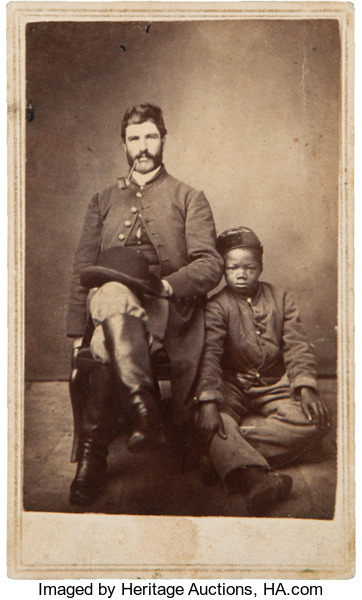
Federal Soldier With His Young Black Servant
Blacks were servants for both the federal army and for the army of the rebelling states during the Civil War. The difference is that in 1863, while the Confederates were still bringing slaves into battle with them, the Union was bringing trained and paid soldiers into battle with them. For over 2 years in the Union army, black men were allowed to be enlistees and officers. For less than a month in the Confederate army, black men were allowed the privilege of identifying themselves among the rank and file. Imagine all the stories you could tell about your week-long experience in battle.
About 90,000 black men who were formerly enslaved in their own country joined the Civil War as soldiers on the Union side. The other half of the black volunteers were free and in total, these men comprised 10% of the army of the United States who saw a mutual enemy in the fighting force of the Confederacy.
To ask if black slaves proudly joined a war against themselves is to ask if black people enjoyed living as slaves. An analysis of 1930s slave narratives reveals that only 3% of interviewed slaves professed a “genuine affection” of their master.
To ask if free blacks who contributed to the Confederacy did so with a conscience that was also free towards people who had none is to ask if black people would have been willing to trade their freedom at any time in their lives for an eternity in slavery for no reason at all. While there is evidence of some free, especially wealthy blacks who did, indeed, support the Confederacy, their community reputation was just as important (if not more essential) to their survival as their property interests.
To ask whether black people would have proudly supported a regime that sought to relegate them to the bottom of society forever while maintaining the supremacy of everyone else is to ask if black people were stupid.
And to put it simply, to claim today that any sane black person actually lived and died for the Confederate States of America, knowing full well that the Confederate States of America was a bad deal for black people, is the same as to claim that you desire our ignorance and we deserve yours.
Sources:
The History Network
http://www.history.com/topics/american-civil-war/black-civil-war-soldiers
http://www.history.com/this-day-in-history/confederacy-approves-black-soldiers
Encyclopedia Virginia
https://www.encyclopediavirginia.org/media_player?mets_filename=evm00002110mets.xml
https://www.encyclopediavirginia.org/Black_Confederates
http://blog.encyclopediavirginia.org/2011/10/feedback-hey-i-know-that-guy/
Civil War Talk
https://civilwartalk.com/threads/three-officers-and-slave-57th-georgia-infantry.123184/
https://civilwartalk.com/threads/confederate-officers-j-w-comer-and-his-servant-burrell.127567/
Georgia College Library Special Collections
(via Flickr)
https://www.flickr.com/photos/gcsuspecialcollections/6426944753
The Journal of Archibald C. McKinley
by Archibald Carlisle McKinley
University of Georgia Press, 1991
back cover
(via Google Books)
Hell's Broke Loose in Georgia: Survival in a Civil War Regiment
by Scott Walker
University of Georgia Press, Jul 1, 2007
page 32, 82-83, and 93
(via Google Books)
The Library of Congress
https://www.loc.gov/item/2014647512/
http://www.loc.gov/rr/print/coll/SoldierbiosChandler.html
New York Times Opinionator
https://opinionator.blogs.nytimes.com/2013/09/24/a-slaves-service-in-the-confederate-army/?_php=true&_type=blogs&_r=0
Museum and White House of the Confederacy
Sons of Confederate Veterans Camp 260 newsletter (2006)
A Youth's History of the Rebellion: From the battle of Murfreesboro' to the massacre at Fort Pillow
J. Miller, 1865
page 111
(via Google Books)
Williamson County Historical Society
https://battleoffranklin.wordpress.com/2011/02/14/john-terrill/
Heritage Auctions
https://historical.ha.com/itm/photography/cdvs/absolutely-one-of-the-most-moving-civil-war-images-we-ve-ever-cataloged-carte-de-visite-of-a-federal-soldier-with-his-young/a/6083-52018.s
#black history#american history#African Americans#american civil war#civil war#confederacy#confederate#confederate states of america#union army#military#military history#slavery#american slavery#u.s. history#black confederates#southern pride#dixie
1 note
·
View note